Winter 2012
Editor’s Note
“It’s like trying to guess what Shakespeare was up to,” said Kevin Gardner, author of The Granite Kiss and husband of theater professor Brenda Foley, hence the apt reference. Kevin was referring to the challenges of interpreting the maze of stone walls, pens and cellar holes left by Marlboro’s first settlers. He and local historian Forrest Holzapfel were leading a field trip to the historic Bishop homestead, at the base of Hogback Mountain, as part of a course this fall semester called The Presence of the Past. One of the central lessons in this class was that much of what we call historic “truth” is subject to interpretation.
You will find several perspectives on the past in this issue of Potash Hill, from the minutia of Marlboro’s early history to alumnus Art Magida’s colorful assessment of prewar Berlin. Art history professor Felicity Ratté sizes up medieval monumental architecture of the Islamic Mediterranean, while alumna Molly MacLeod focuses on the recent past and hopeful future of some of New Jersey’s busiest residents. You’ll learn what students and faculty have been doing on campus, and what alumni are doing almost everywhere else. I encourage you to share your own interpretation of what you find in this issue. You can view responses to the Summer 2011 Potash Hill here.
—Philip Johansson, editor
Front cover: Reflection of Carsi Mosque and National Museum on Kosovo Parliament, Prishtina, Kosovo, part of Colby Silver’s fieldwork in the Balkans.
Table of Contents
Making History in Marlboro
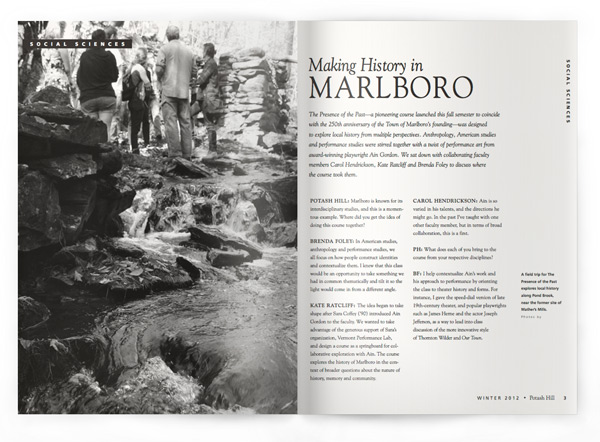
The Presence of the Past—a pioneering course launched this fall semester to coincide with the 250th anniversary of the Town of Marlboro’s founding—was designed to explore local history from multiple perspectives. Anthropology, American studies and performance studies were stirred together with a twist of performance art from award-winning playwright Ain Gordon. We sat down with collaborating faculty members Carol Hendrickson, Kate Ratcliff and Brenda Foley to discuss where the course took them.
POTASH HILL: Marlboro is known for its interdisciplinary studies, and this is a momentous example. Where did you get the idea of doing this course together?
BRENDA FOLEY: In American studies, anthropology and performance studies, we all focus on how people construct identities and contextualize them. I knew that this class would be an opportunity to take something we had in common thematically and tilt it so the light would come in from a different angle.
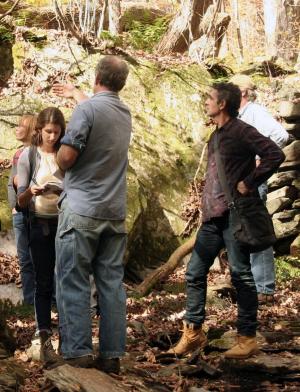 KATE RATCLIFF: The idea began to take shape after Sara Coffey (’90) introduced Ain Gordon to the faculty. We wanted to take advantage of the generous support of Sara’s organization, Vermont Performance Lab, and design a course as a springboard for collaborative exploration with Ain. The course explores the history of Marlboro in the context of broader questions about the nature of history, memory and community.
KATE RATCLIFF: The idea began to take shape after Sara Coffey (’90) introduced Ain Gordon to the faculty. We wanted to take advantage of the generous support of Sara’s organization, Vermont Performance Lab, and design a course as a springboard for collaborative exploration with Ain. The course explores the history of Marlboro in the context of broader questions about the nature of history, memory and community.
CAROL HENDRICKSON: Ain is so varied in his talents, and the directions he might go. In the past I’ve taught with one other faculty member, but in terms of broad collaboration, this is a first.
PH: What does each of you bring to the course from your respective disciplines?
BF: I help contextualize Ain’s work and his approach to performance by orienting the class to theater history and forms. For instance, I gave the speed-dial version of late 19th-century theater, and popular playwrights such as James Herne and the actor Joseph Jefferson, as a way to lead into class discussion of the more innovative style of Thornton Wilder and Our Town.
CH: I’m a learner when it comes to my own state and town, so I look to Kate for insights into history as well as wonderful readings. She keeps us honest and straight about historical facts.
KR: As someone trained in U.S. social and cultural history, I bring a wider historical context to some of the local issues we have been studying. And Carol brings expertise with fieldwork as well as a special attentiveness to material objects. I think of her as our “materials” person.
CH: And sort of “wild idea” person.
KR: And also I want to add the “cross-cultural comparative context” person. Carol can relate Guatemala to just about any subject and make it a rich point of comparison.
CH: And it’s been great having Brenda there too because two of the texts we read were plays, Our Town and Will Eno’s Middletown.
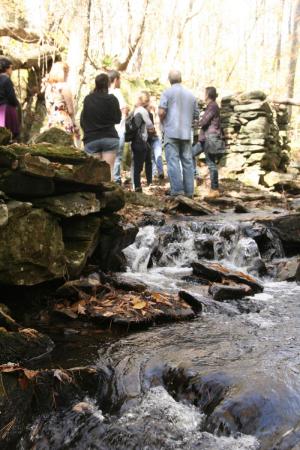 BF: I am always encouraging us to ask the question “Who is the audience?” in any piece of text, photo, pamphlet or public event—and to weigh the stated intention against the performed action. So, I point out and critique as a performance that which was not necessarily constructed nor intended to be received as one.
BF: I am always encouraging us to ask the question “Who is the audience?” in any piece of text, photo, pamphlet or public event—and to weigh the stated intention against the performed action. So, I point out and critique as a performance that which was not necessarily constructed nor intended to be received as one.
KR: These different disciplinary backgrounds—as well as the students’ own backgrounds—create a rich, multilayered quality to the class and the discussions.
PH: And what does Ain Gordon bring into this heady mixture?
BF: In theater and performance, my interests have always been in that which is less readily apparent or easily articulated. Ain is ever after the elusive; no moment, no detail, no historical anecdote is refuse. For Ain, in all that detritus of the past lies potential.
KR: Ain brings a creative skepticism about the whole enterprise of history. As he says, “The idea that history is knowable is a conceit of history.” Ain is drawn to the gaps, to the silences, to the margins, to that which is clearly unknowable. And his aesthetic is to continually bring attention to the constructed nature of the narrative that he’s creating. Over the past several decades, there has been an ongoing conversation about the uneasy relationship between truth and our accounts of it. Historians will say yes, we need to recognize that what we find in the past is always shaped by the cultural categories and assumptions we bring to the work. These postmodern insights are generally acknowledged, but there’s still an impulse to create a story that is more seamless than the kind of work that Ain is doing. He’s an artist, and I’m a professional historian. But the tension between those worlds is incredibly rich and interesting and fruitful.
PH: How has this course added to your understanding of the minutia of local history?
KR: Newton’s History of the Town of Marlborough is the bible of local history. Everybody cites Newton. So it’s been interesting to read Newton and think of him not as a container of facts about Marlboro, but as a historical figure himself, someone interpreting the world through the lens of his own historical moment.
CH: For instance, the language and content of Newton’s letters to his daughter is significantly different from his formal history. That’s really interesting in the context of our course.
BF: In the class we talk about people and places inscribing and performing their own history. We all leave traces, marks, impressions in our wake whether we want to or not. There are the calculated inscriptions like speeches and legislative acts, marriages and partnerships, and choices about whether we set off on our own roads less taken. And “places” make parallel choices, by committee or decree or accident, as to how they want to present in life—whether the town green gets picket fences or stone walls or who gets to lead the Fourth of July parade.
KR: We think of the iconic symbol of the New England landscape—the white steepled church and the orderly commons—as representing “traditional” New England, but that particular version of the town center was the product of a specific moment in the early 19th century. Interestingly, multiple towns in this region, including Newfane, Marlboro and Brattleboro, originally sited their meetinghouses on top of hills, and later moved them down to a more central commons. At this same time, boosters throughout New England set out to improve the landscape of the town common. They looked around and saw ungraded roads criss-crossed with oxcart ruts and unsightly sheds to protect the horses in bad weather. Marlboro’s village center has included over time an ashery, a tannery, blacksmith shop, a wheelwright shop, a wagon maker, a chair factory—industry, all right there. In the landscape aesthetic that was emerging, these activities had no place in the central village district. The new and improved village commons with its white paint and stone walls was seen as a sign of progress, not as an evocation of some traditional landscape.
CH: That was interesting to me, because when the Spanish came to what is now Latin America, they had this vision of what a city center was—a plaza—and they often built right on top of pre-existing structures. Today you can see colonial Catholic churches that were built on top of Maya temples right on the edge of plazas. All of this reflects deep roots that go way back into Maya and European pasts. So, to find out that the New England commons is a 19th-century development, as opposed to something that was there for years and years, was a revelation to me.
PH: What are some of the creative anthropological, historical, theatrical outcomes students are coming up with?
CH: We’re really pushing students to think creatively beyond a term paper and come up with something that is relevant to the class or the history of Marlboro or southeast Vermont and that challenges them to think in different ways.
KR: We’re also trying to get them to communicate what they’ve learned to a broader audience. For example, one student is writing letters between Marlboro College students in different eras; another is creating a diary based on the life of Mrs. Whitmore, a midwife and early settler; and a third is writing a play based on the idea of disease and illness in the late 18th century and how high mortality rates affected the local population.
CH: These creative projects, then, loop back into the realm of needing to require students to know historically specific details, what are considered “facts.” A student writing a diary or a set of letters from a particular era needs to know a lot about that era and how people would have written and what allusions they would have made—but not in a 21st-century way.
BF: What we’re exploring in this class is the extraordinarily rich historical detail available to students who take the time to reach into creaky attics and small town archives. They uncover inscriptions left by people who hadn’t necessarily thought of their records as a performance but who must have anticipated an audience of, at least, one reader. And in that act of communication lies a kind of inscribed performance.
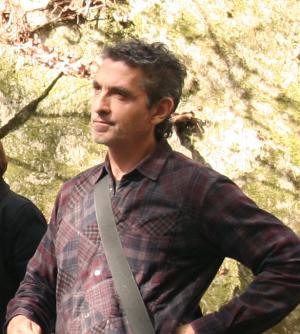 Ain Gordon (right) is a three-time Obie Award–winning playwright, director and actor whose work deals with issues of place and memory by unearthing disappearing history. His recent work includes A Disaster Begins, about one woman’s bond with the hurricane of 1900 in Galveston, Texas, and In This Place…, inspired by the first free African-Americans to build their own home in Lexington, Kentucky. Ain is a visiting artist at the Pew Center for Arts & Heritage, artist-In-residence at the Center for Creative Research and co-director of the Pick Up Performance Co(s). He first came to Marlboro as part of the Embodied Learning Symposium in April (Potash Hill, Summer 2011).
Ain Gordon (right) is a three-time Obie Award–winning playwright, director and actor whose work deals with issues of place and memory by unearthing disappearing history. His recent work includes A Disaster Begins, about one woman’s bond with the hurricane of 1900 in Galveston, Texas, and In This Place…, inspired by the first free African-Americans to build their own home in Lexington, Kentucky. Ain is a visiting artist at the Pew Center for Arts & Heritage, artist-In-residence at the Center for Creative Research and co-director of the Pick Up Performance Co(s). He first came to Marlboro as part of the Embodied Learning Symposium in April (Potash Hill, Summer 2011).
Brenda Foley is professor of theater and author of Undressed for Success: Beauty Contestants and Exotic Dancers as Merchants of Morality (Palgrave Macmillan, 2005). Her research interests are in performance studies, pop culture, feminism, contemporary theater and disability studies.
Carol Hendrickson is professor of anthropology and author of Weaving Identities: Construction of Dress and Self in a Highland Guatemala Town (University of Texas Press, 1995). She co-wrote Tecpán Guatemala: A Modern Maya Town in Global and Local Context (Westview, 2002) with Edward Fischer.
Kate Ratcliff is professor of American studies at Marlboro, where her teaching ranges from the Federalist Papers to post–World War II television sitcoms. She recently joined the board of the Vermont Academy of Arts and Sciences and participated in a panel on Vermont history at the fall conference.
Made in and around Vermont
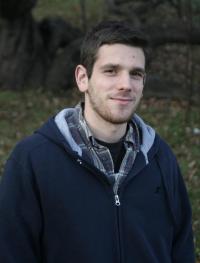 “Anyone who studies colonial America will quickly realize that no part of our history, and no geographic area, is a vacuum,” said senior Alex Tolstoi. “Everything affects everything.” For his Plan of Concentration, Alex is examining the social and political influences of neighboring colonies on 18th-century Vermont, drawing in part on historic captivity narratives. By learning about differing social and economic structures of colonial New England and New York, Alex plans to show how leaders in the Green Mountain region created a Vermont identity and raised support for an independent Republic of Vermont. “This Republic had one of the first constitutions to outlaw slavery, had no landownership requirement for suffrage and became involved in an international affair over the possibility of rejoining the English Empire.”
“Anyone who studies colonial America will quickly realize that no part of our history, and no geographic area, is a vacuum,” said senior Alex Tolstoi. “Everything affects everything.” For his Plan of Concentration, Alex is examining the social and political influences of neighboring colonies on 18th-century Vermont, drawing in part on historic captivity narratives. By learning about differing social and economic structures of colonial New England and New York, Alex plans to show how leaders in the Green Mountain region created a Vermont identity and raised support for an independent Republic of Vermont. “This Republic had one of the first constitutions to outlaw slavery, had no landownership requirement for suffrage and became involved in an international affair over the possibility of rejoining the English Empire.”
Tough Love in the Garden State
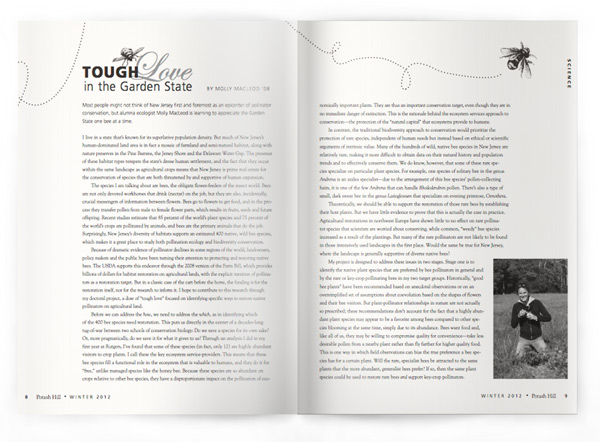
By Molly MacLeod ’08
Most people might not think of New Jersey first and foremost as an epicenter of pollinator conservation, but alumna ecologist Molly MacLeod is learning to appreciate the Garden State one bee at a time.
I live in a state that’s known for its superlative population density. But much of New Jersey’s human-dominated land area is in fact a mosaic of farmland and semi-natural habitat, along with nature preserves in the Pine Barrens, the Jersey Shore and the Delaware Water Gap. The presence of these habitat types tempers the state’s dense human settlement, and the fact that they occur within the same landscape as agricultural crops means that New Jersey is prime real estate for the conservation of species that are both threatened by and supportive of human expansion.
The species I am talking about are bees, the obligate flower-feeders of the insect world. Bees are not only devoted workhorses that drink (nectar) on the job, but they are also, incidentally, crucial messengers of information between flowers. Bees go to flowers to get food, and in the process they transfer pollen from male to female flower parts, which results in fruits, seeds and future offspring. Recent studies estimate that 85 percent of the world’s plant species and 75 percent of the world’s crops are pollinated by animals, and bees are the primary animals that do the job. Surprisingly, New Jersey’s diversity of habitats supports an estimated 400 native, wild bee species, which makes it a great place to study both pollination ecology and biodiversity conservation.
Because of dramatic evidence of pollinator declines in some regions of the world, landowners, policy makers and the public have been turning their attention to protecting and restoring native bees. The USDA supports this endeavor through the 2008 version of the Farm Bill, which provides billions of dollars for habitat restoration on agricultural lands, with the explicit mention of pollinators as a restoration target. But in a classic case of the cart before the horse, the funding is for the restoration itself, not for the research to inform it. I hope to contribute to this research through my doctoral project, a dose of “tough love” focused on identifying specific ways to restore native pollinators on agricultural land.
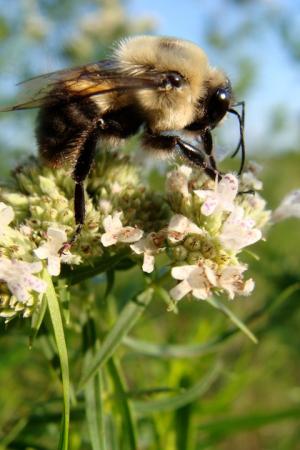 Before we can address the how, we need to address the which, as in identifying which of the 400 bee species need restoration. This puts us directly in the center of a decades-long tug-of-war between two schools of conservation biology: Do we save a species for its own sake? Or, more pragmatically, do we save it for what it gives to us? Through an analysis I did in my first year at Rutgers, I’ve found that some of these species (in fact, only 12) are highly abundant visitors to crop plants. I call these the key ecosystem service-providers. This means that these bee species fill a functional role in the ecosystem that is valuable to humans, and they do it for “free,” unlike managed species like the honey bee. Because these species are so abundant on crops relative to other bee species, they have a disproportionate impact on the pollination of economically important plants. They are thus an important conservation target, even though they are in no immediate danger of extinction. This is the rationale behind the ecosystem services approach to conservation—the protection of the “natural capital” that ecosystems provide to humans.
Before we can address the how, we need to address the which, as in identifying which of the 400 bee species need restoration. This puts us directly in the center of a decades-long tug-of-war between two schools of conservation biology: Do we save a species for its own sake? Or, more pragmatically, do we save it for what it gives to us? Through an analysis I did in my first year at Rutgers, I’ve found that some of these species (in fact, only 12) are highly abundant visitors to crop plants. I call these the key ecosystem service-providers. This means that these bee species fill a functional role in the ecosystem that is valuable to humans, and they do it for “free,” unlike managed species like the honey bee. Because these species are so abundant on crops relative to other bee species, they have a disproportionate impact on the pollination of economically important plants. They are thus an important conservation target, even though they are in no immediate danger of extinction. This is the rationale behind the ecosystem services approach to conservation—the protection of the “natural capital” that ecosystems provide to humans.
In contrast, the traditional biodiversity approach to conservation would prioritize the protection of rare species, independent of human needs but instead based on ethical or scientific arguments of intrinsic value. Many of the hundreds of wild, native bee species in New Jersey are relatively rare, making it more difficult to obtain data on their natural history and population trends and to effectively conserve them. We do know, however, that some of these rare species specialize on particular plant species. For example, one species of solitary bee in the genus Andrena is an azalea specialist—due to the arrangement of this bee species’ pollen-collecting hairs, it is one of the few Andrena that can handle Rhododendron pollen. There’s also a type of small, dark sweat bee in the genus Lasioglossum that specializes on evening primrose, Oenothera.
Theoretically, we should be able to support the restoration of those rare bees by establishing their host plants. But we have little evidence to prove that this is actually the case in practice. Agricultural restorations in northwest Europe have shown little to no effect on rare pollinator species that scientists are worried about conserving, while common, “weedy” bee species increased as a result of the plantings. But many of the rare pollinators are not likely to be found in those intensively used landscapes in the first place. Would the same be true for New Jersey, where the landscape is generally supportive of diverse native bees?
My project is designed to address these issues in two stages. Stage one is to identify the native plant species that are preferred by bee pollinators in general and by the rare or key-crop pollinating bees in my two target groups. Historically, “good bee plants” have been recommended based on anecdotal observations or on an oversimplified set of assumptions about coevolution based on the shapes of flowers and their bee visitors. But plant-pollinator relationships in nature are not actually so prescribed; these recommendations don’t account for the fact that a highly abundant plant species may appear to be a favorite among bees compared to other species blooming at the same time, simply due to its abundance. Bees want food and, like all of us, they may be willing to compromise quality for convenience—take less desirable pollen from a nearby plant rather than fly farther for higher quality food. This is one way in which field observations can bias the true preference a bee species has for a certain plant. Will the rare, specialist bees be attracted to the same plants that the more abundant, generalist bees prefer? If so, then the same plant species could be used to restore rare bees and support key-crop pollinators.
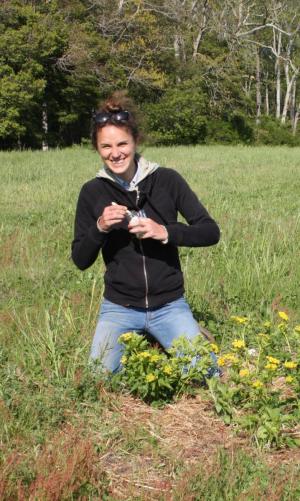 To answer this question, I worked from April to September last year at a U.S. Natural Resources Conservation Service site near Cape May, New Jersey, observing an experimental bee buffet. At this site I had a field full of 26 native plant species, each planted in multiple, one-square-meter, single-species plots. The plants were chosen for this study because they were known to be generally attractive to pollinators but had not been compared with each other in a controlled setting or evaluated for their ease of cultivation. To assess the attractiveness of each plant species, I net-captured all of the flower visitors to each plot on four separate days during that plot’s peak bloom. It’s possible to identify some bees “on the wing,” but to know exactly which bees in my target groups are visiting these plants, I had to net-collect them and bring them back to the lab for identification.
To answer this question, I worked from April to September last year at a U.S. Natural Resources Conservation Service site near Cape May, New Jersey, observing an experimental bee buffet. At this site I had a field full of 26 native plant species, each planted in multiple, one-square-meter, single-species plots. The plants were chosen for this study because they were known to be generally attractive to pollinators but had not been compared with each other in a controlled setting or evaluated for their ease of cultivation. To assess the attractiveness of each plant species, I net-captured all of the flower visitors to each plot on four separate days during that plot’s peak bloom. It’s possible to identify some bees “on the wing,” but to know exactly which bees in my target groups are visiting these plants, I had to net-collect them and bring them back to the lab for identification.
Once I have all of my bees identified, I’ll rank the plants by their attractiveness based on the totals of bee abundance and diversity per species. But it wouldn’t be fair to compare a spring-blooming plant like Penstemon with a late-summer-blooming goldenrod, because the abundance and identity of bees between those times of the year are markedly different, so I’ll compare early-, mid- and late-blooming plants separately. In 2010, the first year data were collected, nine plant species were ranked as most attractive. For 2011, I’ll see whether I get the same results from more-established plants. But the real litmus test will be to see how these plants stack up next to existing restorations that were established without the bee preference data I’m collecting. This broader context will be stage two of my thesis work. Will targeted plantings using my most attractive species restore those key bee groups more effectively than previous restoration efforts? I’ll test this idea by establishing mixed-species plots in six separate sites across New Jersey. Each site will also contain an existing restoration plot and an unrestored control—an area that best represents the site’s conditions before any restoration took place. I’ll compare bee visitation to these plots over the next few years to better understand whether our current restorations are making a dent and how to better tailor them for the species that need it most.
Answering these questions would ensure that the Farm Bill funding is effective both for rare species and for species that play a key economic role in crop production. Support for insect conservation is practically nonexistent outside of this bill, due in part to a lack of biological information on most species necessary for informed, targeted conservation plans. Certainly, this lack of funding is also due to the fact that many insects are given a bad rap because of some species that are considered noxious or aggressive. Meanwhile, the tug-of-war between saving species for their own sake and saving them for more selfserving reasons makes it difficult to know where to start. Can we therefore take what little funding we have, and dovetail these divergent conservation goals? I hope so. The business of a successful restoration lies in thrifty diplomacy, and in practice it depends on a balance between well-informed risks and leaps of faith. Striking that balance is where the tough love comes in—the faith that the right connections can be made, the knowledge that they won’t just make themselves and the willingness to work for them. In the case of pollinators, we need to make that first, deliberate move.
Molly MacLeod graduated from Marlboro in 2008 with a Plan of Concentration in ecology and conservation, including a project on pollination in forest patches. She is continuing her research on pollination while pursuing a doctoral degree in ecology and evolution at Rutgers University.
Pollination Deviation
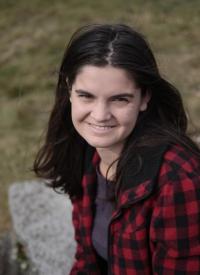 Most of us are familiar with the idea of bees visiting flowers, but pollinators can take more unusual forms, such as lizards, rodents and primates. For her Plan of Concentration, senior Joella Simons Adkins is focusing on one group of nonconventional pollinators known as “non-flying mammals,” a.k.a. mammals other than bats. “It has been found that non-flying mammals, mainly rodents and elephant shrews, pollinate many species in the flowering plant family Proteaceae in South Africa and Australia,” said Joella. “Specialized floral traits found in South African Protea species include robust flowers situated at ground level, dull coloration, a strong yeasty odor and copious amounts of nectar that is available at night when the rodents are active.” Protea species in Australia, on the other hand, have more generalized flowers and a wider range of visitors, including birds, insects and mammals.
Most of us are familiar with the idea of bees visiting flowers, but pollinators can take more unusual forms, such as lizards, rodents and primates. For her Plan of Concentration, senior Joella Simons Adkins is focusing on one group of nonconventional pollinators known as “non-flying mammals,” a.k.a. mammals other than bats. “It has been found that non-flying mammals, mainly rodents and elephant shrews, pollinate many species in the flowering plant family Proteaceae in South Africa and Australia,” said Joella. “Specialized floral traits found in South African Protea species include robust flowers situated at ground level, dull coloration, a strong yeasty odor and copious amounts of nectar that is available at night when the rodents are active.” Protea species in Australia, on the other hand, have more generalized flowers and a wider range of visitors, including birds, insects and mammals.
Seeing the city from all sides of the Middle Sea

By Felicity Ratté
Art history professor Felicity Ratté spent her sabbatical last year traveling and expanding on her research regarding medieval urban design around the Mediterranean.
Although my research focuses on the monumental centers of cities in medieval Italy, during my sabbatical I turned my analytical lens on the same sites in key cities of the Islamic world. I was looking for correspondences between approaches to architecture that emphasized the role of monumental sites in civic rituals. In particular, I examined attention to scale, site, architectural detailing or particular features that were designed to be seen either in passing—as one walked by a building during a procession—or as one stood before a building while something happened within or in front of it.
This research was motivated by a sense that the public discourse that now describes the interaction between Europe/America and the Islamic world as a “clash of civilizations” erases the historic fact of cultural interdependence. I set out to look for evidence of this interdependence in the built environment of North Africa, the Middle East and Turkey from the 14th century, the period I study in Italy. The particular focus of this analysis was both monumental building types, such as mosques, madrasas (schools) and mausolea, and urban design practice such as the layout and location of fountains, souks (markets) and public space.
In the cities of the Islamic Mediterranean, I found much evidence of architectural design that was powerfully influenced by the symbolic role that buildings play for the urban population. I have begun now to understand how this influence can be productively compared to what was going on in Italy at the same time.
Although my work has only just begun, and there is still much that I need to do in order to justify this type of comparative study, I have come closer to understanding the multiple and highly complex models of urban practice, design and use in the Islamic world. In addition, from Tangiers to Kayseri, I was privileged to encounter spontaneous and ritual acts of kindness, sympathy and welcome that reinforced my impression of cultural concurrence and enriched my research in ways that are beyond measure.
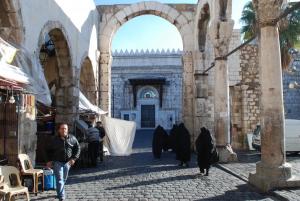 Colonial scholars erroneously maintained that there was little evidence of urban design in Islamic cities; any apparent evidence was considered inferior to what the Muslims inherited from classical cities. I found a perfect example of this error in Damascus, a Roman, then Byzantine city taken by the Arabs in 636 CE. Here you see the remains of the western propylaeum that leads up to the former Temple of Jupiter, which was transformed into the Great Mosque of Damascus in 706. The careful transformation of Damascus into an Islamic capital confirms the presence of sophisticated urban design practices.
Colonial scholars erroneously maintained that there was little evidence of urban design in Islamic cities; any apparent evidence was considered inferior to what the Muslims inherited from classical cities. I found a perfect example of this error in Damascus, a Roman, then Byzantine city taken by the Arabs in 636 CE. Here you see the remains of the western propylaeum that leads up to the former Temple of Jupiter, which was transformed into the Great Mosque of Damascus in 706. The careful transformation of Damascus into an Islamic capital confirms the presence of sophisticated urban design practices.
 Contrary to colonialist and even modern media preconceptions, I found similarities in urban design and use between Italy and the Islamic Mediterranean. In Fez, for example, I found evidence of processional activity that purposefully linked different sections of the city together, such as this procession for the Festival of Moulay Idris (below). This connection is a noteworthy phenomenon found in Italy as well. The monumental portal of the Andalusian mosque (above) markedly distinguishes the building from the rest of the buildings around it, suggesting a hierarchy of structures that could be read from the street.
Contrary to colonialist and even modern media preconceptions, I found similarities in urban design and use between Italy and the Islamic Mediterranean. In Fez, for example, I found evidence of processional activity that purposefully linked different sections of the city together, such as this procession for the Festival of Moulay Idris (below). This connection is a noteworthy phenomenon found in Italy as well. The monumental portal of the Andalusian mosque (above) markedly distinguishes the building from the rest of the buildings around it, suggesting a hierarchy of structures that could be read from the street.
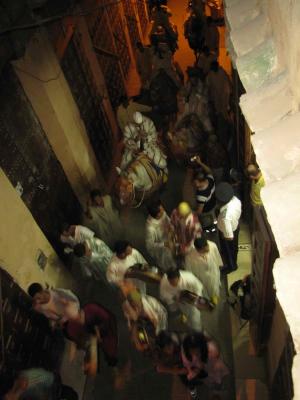
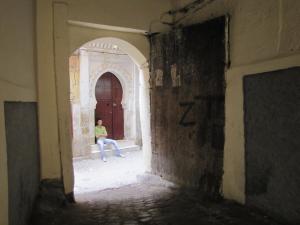 I found some architectural details of Islamic cities that were very different from what existed in Italy. For example, a very interesting feature common to many of the cities I studied is interior gates, such as the examples here from Fez (above) and Tunis (below). These gates could be closed to reroute traffic or for enhanced security. Despite these differences, however, the principles of urban iconography—the style of built elements as well as their siting—are strikingly similar to those found in medieval cities of Italy.
I found some architectural details of Islamic cities that were very different from what existed in Italy. For example, a very interesting feature common to many of the cities I studied is interior gates, such as the examples here from Fez (above) and Tunis (below). These gates could be closed to reroute traffic or for enhanced security. Despite these differences, however, the principles of urban iconography—the style of built elements as well as their siting—are strikingly similar to those found in medieval cities of Italy.
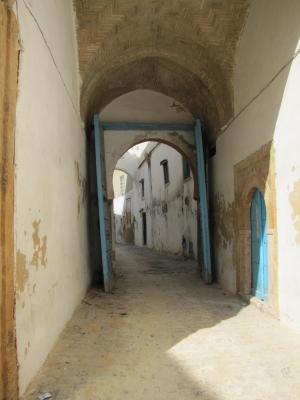
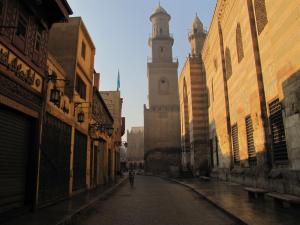 The city in which I found the most, and most remarkable, correspondences with what I know of in Florence was Cairo, historic capital of the Mamluk dynasty. Here you can see, for example, the similarities between Cairo’s Bayn al Qasrayn (above) and Florence’s Piazza della Signoria (below). Monumental architectural complexes in Cairo, such as the mosque, madrasa and mausoleum of Sultan Qalawun (c. 1284), were designed as backdrops to civic rituals, just as churches and public palaces were in Florence.
The city in which I found the most, and most remarkable, correspondences with what I know of in Florence was Cairo, historic capital of the Mamluk dynasty. Here you can see, for example, the similarities between Cairo’s Bayn al Qasrayn (above) and Florence’s Piazza della Signoria (below). Monumental architectural complexes in Cairo, such as the mosque, madrasa and mausoleum of Sultan Qalawun (c. 1284), were designed as backdrops to civic rituals, just as churches and public palaces were in Florence.
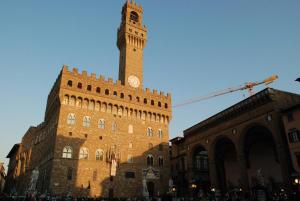
 Although the historic context for urban design and subsequent history in Anatolia is quite different from that in North Africa and the Levant, there were consistencies in how buildings were used symbolically. For example, the portal of the Sifaiye Madrasa, a Seljuk building built in c.1217, was literally overshadowed by the larger Cifte Minerali Madrasa across the street, built later by Mongol rulers when they took control of Sivas in the 1270s. This is a terrific example of how power politics played out in stone, and is reminiscent of the competition between buildings in medieval Italy.
Although the historic context for urban design and subsequent history in Anatolia is quite different from that in North Africa and the Levant, there were consistencies in how buildings were used symbolically. For example, the portal of the Sifaiye Madrasa, a Seljuk building built in c.1217, was literally overshadowed by the larger Cifte Minerali Madrasa across the street, built later by Mongol rulers when they took control of Sivas in the 1270s. This is a terrific example of how power politics played out in stone, and is reminiscent of the competition between buildings in medieval Italy.
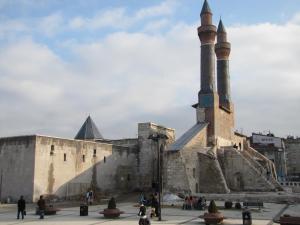
Felicity Ratté is professor of art history at Marlboro and author of Picturing the City in Medieval Italy. You can learn more about her research last year at http://cosmo.marlboro.edu/fratte/travel/.
Reconstructing Balkan Heritage
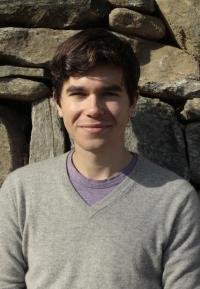 Just when Felicity was winding down her travels, senior Colby Silver received a summer research grant for several weeks of fieldwork in Kosovo, Bosnia-Herzegovina and Dalmatia. In this region ravaged by war in the 1990s, Colby documented the destruction of architectural heritage and subsequent efforts to reconstruct and conserve historic buildings and sites. “Sadly, the use of heritage often does not become perceptible to the general population until it is lost or at risk of disappearing,” said Colby. His Plan of Concentration focuses on sites significant to specific communities, such as Ottoman mosques and Serbian monasteries, which were often targeted during the war. “Given the complex interwoven fabric of religious and ethnic groups in the Balkans, the region presents a particularly poignant and varied example of heritage valuation and loss.”
Just when Felicity was winding down her travels, senior Colby Silver received a summer research grant for several weeks of fieldwork in Kosovo, Bosnia-Herzegovina and Dalmatia. In this region ravaged by war in the 1990s, Colby documented the destruction of architectural heritage and subsequent efforts to reconstruct and conserve historic buildings and sites. “Sadly, the use of heritage often does not become perceptible to the general population until it is lost or at risk of disappearing,” said Colby. His Plan of Concentration focuses on sites significant to specific communities, such as Ottoman mosques and Serbian monasteries, which were often targeted during the war. “Given the complex interwoven fabric of religious and ethnic groups in the Balkans, the region presents a particularly poignant and varied example of heritage valuation and loss.”
Summer in Berlin

By Arthur Magida ’67
In The Nazi Séance, Arthur Magida chronicles the ascent of Erik Jan Hanussen, a Jewish psychic who became so popular in 1930s Berlin that he even rubbed elbows with high-ranking Nazis. In this excerpt, Hanussen returns to the colorful Berlin of the Weimar Republic after having his clairvoyant powers vindicated in a Czech court. It is the year before Hitler’s meteoric rise to power.
On May 28, 1932, the day after Hanussen’s victory in Leitmeritz, he boarded a train for Berlin. He was returning as the curtain was going up on the season which had thrilled Mark Twain. “Summer in Berlin,” Twain wrote, “is the perfection of the beautiful.” But Twain hadn’t been there since 1891, and the city had changed immensely. It was more elegant and cosmopolitan. Its streets, noted a Baedeker guide, were “a model of cleanliness,” its squares were “embellished with gardens, monuments and fountains,” its bridges were “beautified with sculpture.” Three quarters of the city’s buildings were “quite modern” and broad boulevards like the Lustgarten, the Opera Platz and the Linden were forming “magnificent thoroughfare[s] of the first rank.”
In 1920, Berlin absorbed seven towns, 59 villages and extensive landholdings that had been used exclusively by royalty, making it ten times the size of Paris. And it wasn’t shy about this, not in this age of nationalism and chauvinism. One newspaper headline blared in capital letters: we have 1.5 million more people than Paris; with 500,000 lines the city has the highest ratio of people to telephones. Another newspaper bragged: we have the fastest underground rail system in the world. And it was one of the cheapest: you could ride the system’s entire 452 miles for only 25 pfennings—half the price of a gallon of milk and 75 pfennings less than a pound of beef.
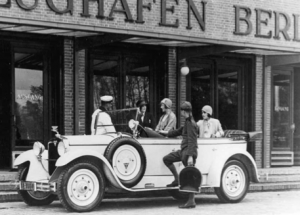 The city was eminently livable. Berlin’s zoo was one of the best in Europe; its film theaters were the most up-to-date; and Luna Park, the city’s most popular amusement park, was mobbed on weekends and summer evenings. Most people went there to cool off on the park’s long water slide or to swim in the pool whose artificial waves were almost as large as those in the ocean. And once a week, the pool held Naked Day so Berliners could enjoy Germany’s new fascination with nudity.
The city was eminently livable. Berlin’s zoo was one of the best in Europe; its film theaters were the most up-to-date; and Luna Park, the city’s most popular amusement park, was mobbed on weekends and summer evenings. Most people went there to cool off on the park’s long water slide or to swim in the pool whose artificial waves were almost as large as those in the ocean. And once a week, the pool held Naked Day so Berliners could enjoy Germany’s new fascination with nudity.
Thousands of artists and writers were swarming to Berlin: Marc Chagall, Vladimir Nabokov, Christopher Isherwood, W. H. Auden, Paul Klee, Josef Albers—all of them working furiously by day, then talking late into the night at cafes like the Café des Westens, which—for obvious reasons—was nicknamed “The Megalomaniacs Café.”
With 45 theaters, dozens of concert halls, excellent conservatories and the most relaxed censorship laws in Europe, Berlin was the crossroads of high-brow, mid-brow and the avant-garde: Babylon and the Renaissance rolled into one.
But there were two Berlins, and the city’s days as a cauldron of creativity were numbered. In Before the Deluge, Otto Friedrich’s memoir about Berlin in the years leading up to the Second World War, he wisely and elegiacally writes that this was “a city unlike any other, we tell ourselves, not only because of what it was but because of the fate that lay before it. . . . We know that Berlin was a doomed city—as doomed as Pompeii—even at the height of its flowering under the benevolent glare of the Weimar eagle.” Away from the bright lights and the cafes and the artists’ garrets, Berlin was crumbling. The stone lions outside the palace at the end of the Unter den Linden were uncharacteristically quiet. The myth was that they roared whenever a virgin walked by, but it was hard to find a virgin
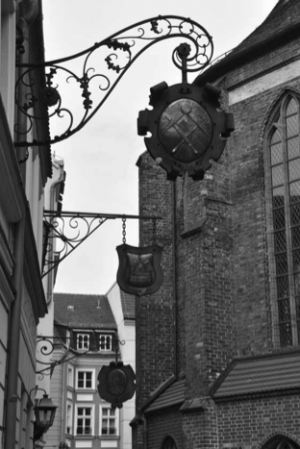 in Berlin. As many as 100,000 whores were walking the streets. Many had moved to Berlin to be domestic servants, then realized that their wages didn’t allow them to live decently in the big city. Twenty-one thousand children were crippled. Forty-four thousand veterans, sick or maimed from the First World War, were begging in the streets. Thirty-five thousand women were widowed from the war. There was one murder every three days and over 50,000 burglaries, forgeries and swindles every year. Young girls barely into their teens were prostituting themselves after school with their parents’ permission.
in Berlin. As many as 100,000 whores were walking the streets. Many had moved to Berlin to be domestic servants, then realized that their wages didn’t allow them to live decently in the big city. Twenty-one thousand children were crippled. Forty-four thousand veterans, sick or maimed from the First World War, were begging in the streets. Thirty-five thousand women were widowed from the war. There was one murder every three days and over 50,000 burglaries, forgeries and swindles every year. Young girls barely into their teens were prostituting themselves after school with their parents’ permission.
The slums of Chicago, the gangsters of New York, the sorrows of Dickens’ London had descended on Berlin. Away from the late night discussions about art and politics and philosophy, Berlin was a symphony of pain. Inflation was so bad that housewives burned their worthless paper currency to heat their homes. One egg cost as much as 30 million eggs before the war. Almost every day, one more person used their entire savings for a tram ride to the other side of the city, where they threw themselves off a bridge. When Wall Street collapsed in 1929 and the Americans called in their German loans, unemployment tripled, then that number doubled. The country was tottering, torn between democrats, Communists and fascists, and Berlin, the capital, was crumbling under the never-ending and always worsening crises. New to democracy, which had begun only in 1918 when the Kaiser abdicated, the city—and the whole country—was breaking down.
This was Hanussen’s home. The cripples and the widows and the homeless didn’t know about him. If they had, they wouldn’t have cared. Life, for them, was too much of a grind. Rather, his audience was the people who enjoyed theater and spectacle and the avant-garde. And of course, much of his following would come from the same people who were attracted to the seers and the fortunetellers who had swarmed to Berlin after the armistice. Once the war was over, reason was given a vacation. The mind could think its way out of only so much misery. Throughout Europe, the lamentations for the dead and the maimed were loud. They were louder in Berlin, which is why so many practitioners of the psychic arts—20,000 by one count, up from 600 in 1900—flocked here. Hanussen knew this was his moment. What better place for him than Berlin, city of glitter, glitz and sorrow? Hanussen was many things, but he was never cautious. The troops from the right and the left were lining up. Hanussen didn’t care about that. He had left Leitmeritz a hero. It was time, he was sure, for the city to line up before him.
From The Nazi Séance by Arthur J. Magida. Copyright © 2011 by the author and reprinted by permission of Palgrave Macmillan, a division of Macmillan Publishers Ltd.
Arthur Magida is writer-in-residence at the University of Baltimore and a journalism professor at Georgetown University. His books, including The Rabbi and the Hit Man and Prophet of Rage: A Life of Louis Farrakhan and His Nation, can be found at www.arthurmagida.com.
The Art of Folkishness
Long before the extreme nationalism of the Third Reich, there was the more benign nationalism of the German folk movement in the early 19th century. For her Plan of Concentration in music, senior Rebecca Gildea is exploring the concept of “the folk” in German history, with all its nationalistic associations and impacts on music. “There are so many qualities and hidden meanings that are assumed when we talk about folk music, and those change every time you consider a different kind of folk music, whether ‘African,’ or ‘American,’ or ‘Hungarian,’” said Rebecca. “My Plan follows where these qualities and assumptions come from during the early folk movement in Germany, and how they were expressed and elaborated on in music.”
Gorilla Morality

By Kathryn Lyon ’13
Illustration by Evan Lorenzen ’13
Suppose you were to come across a human and an ape dangling from the side of a cliff. The two are of arguably equal intelligence and have an equal capacity for suffering. You might correctly assess that both creatures have the same interest in being alive. This being said, how do you choose which being to save, or which to save first? Which choice is morally correct? These questions concern not morality in general, but rather our moral obligations to animals.
Morality is a human notion. Despite this, some animal rights advocates argue for moral laws across the animal kingdom. Martha Nussbaum, for example, proposes “the gradual formation of an interdependent world in which all species will enjoy cooperative and mutually supportive relations with one another.” Apparently, she suggests replacing what is natural with what she views as just. But Nussbaum disregards the fact that animals have no concept of morality themselves.
For example, a lion does not take a gazelle’s interests into perspective before attacking it. Peter Singer, author of All Animals Are Equal, might claim that the lion is acting “speciesist”—allowing the interests of its own species to override the greater interests of other species. Singer would view it as our human duty to interfere on behalf of the gazelle, ensuring that both animals’ interests are equally considered. But only by human standards could putting one’s own species above others ever be seen as wrong; every other species on the planet puts its own interests first. So while theories of animal morality determine appropriate human treatment of animals, they cannot regulate interaction between other animal species.
 Because we are human we value human life above animal life, and thus our survival above theirs; we hold our own interests above those of other animals. If we were to consider only our own interests, “morality” would not even enter into the equation. The more comfortable we are within our lifestyles, however, the more apt we are to establish rules and regulations regarding morality or ethics. Because we are not directly competing with other species for survival, we can take their interests into account. In doing so, I believe we have the responsibility to recognize that we cannot cause animals to suffer in exchange for mere human wants.
Because we are human we value human life above animal life, and thus our survival above theirs; we hold our own interests above those of other animals. If we were to consider only our own interests, “morality” would not even enter into the equation. The more comfortable we are within our lifestyles, however, the more apt we are to establish rules and regulations regarding morality or ethics. Because we are not directly competing with other species for survival, we can take their interests into account. In doing so, I believe we have the responsibility to recognize that we cannot cause animals to suffer in exchange for mere human wants.
Every sentient being has an interest in avoiding pain. I maintain that their interests should not be compromised for anything less than the human interest in avoiding pain. Thus, harmful practices that do not alleviate human pain and suffering, such as the use of animals in the entertainment industry or for cosmetics testing, are not morally justified. Regarding animals as test subjects for medical research, human bias dictates that they should be used before we use members of our own species—but only in situations where researching upon a human would also be justified. In other words, while the discriminatory practice of testing on animals before humans is not immoral, unnecessary harm to sentient animals is.
Similarly, while consuming animals is not inherently immoral, if we have the means to survive as vegetarians, we have the moral responsibility to avoid killing animals for food out of respect for their lives and their interests in being alive. Because we would not eat humans, we should not eat animals. However, in situations where vegetarianism is not an option, it is not immoral for people to survive by eating animals. When survival is at stake, surely it is “better” to eat an animal than a person.
Returning to the cliff-hanging scenario, it is clear that a moral, rational human would save the person first. Despite idealist theory, the obligation to our own species demands that we sacrifice the ape to save the human. Any moral code must be subjective, as it may change according to the specific situation in which it is applied. Human existence is a balance between following the most moral practices one can and surviving.
I recognize that from a universal perspective this is not “fair” to non-human animals; however, as humans we owe our loyalty to the species Homo sapiens. Human perspective is inherently biased, but it is the only perspective from which we can address this issue. It is impossible for humans to truly consider moral equality for animals when we have our own interests in survival at stake. What is immoral is for humans to hurt animals unnecessarily or kill them frivolously. Whenever the resources exist to do so, animal life or suffering must be spared. We have a moral duty to the animals of this world, but foremost we have a duty to our species.
Kathryn Lyon is a sophomore at Marlboro and winner of last year’s Freshman/Sophomore Essay Prize, awarded each year for the best essay written for any course. This article is adapted from her essay, “Animal Morality in Concentric Circles,” written for her Environmental Philosophy class.
On & Off the Hill
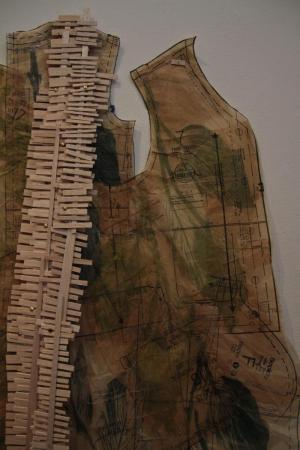 Learn about new faculty members, a journey to Cambodia, responses to Tropical Storm Irene, events in theater and film, notable students, faculty and staff, and more. Marlboro community members are everywhere.
Learn about new faculty members, a journey to Cambodia, responses to Tropical Storm Irene, events in theater and film, notable students, faculty and staff, and more. Marlboro community members are everywhere.
New faculty members bring fresh ideas in music, writing
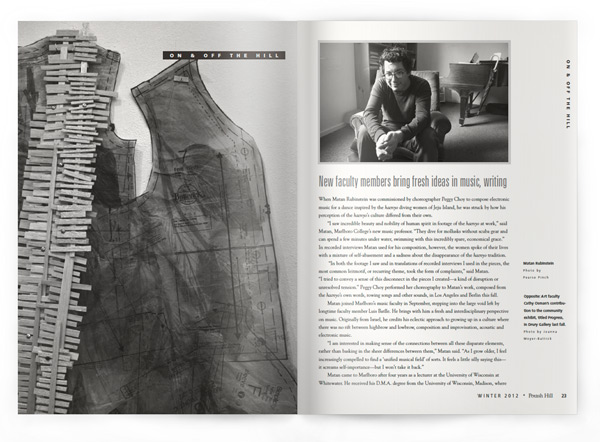
When Matan Rubinstein was commissioned by choreographer Peggy Choy to compose electronic music for a dance inspired by the haenyo diving women of Jeju Island, he was struck by how his perception of the haenyo’s culture differed from their own.
“I saw incredible beauty and nobility of human spirit in footage of the haenyo at work,” said Matan, Marlboro College’s new music professor. “They dive for mollusks without scuba gear and can spend a few minutes under water, swimming with this incredibly spare, economical grace.” In recorded interviews Matan used for his composition, however, the women spoke of their lives with a mixture of self-abasement and a sadness about the disappearance of the haenyo tradition.
“In both the footage I saw and in translations of recorded interviews I used in the pieces, the most common leitmotif, or recurring theme, took the form of complaints,” said Matan. “I tried to convey a sense of this disconnect in the pieces I created—a kind of disruption or unresolved tension.” Peggy Choy performed her choreography to Matan’s work, composed from the haenyo’s own words, rowing songs and other sounds, in Los Angeles and Berlin this fall.
Matan joined Marlboro’s music faculty in September, stepping into the large void left by longtime faculty member Luis Batlle. He brings with him a fresh and interdisciplinary perspective on music. Originally from Israel, he credits his eclectic approach to growing up in a culture where there was no rift between highbrow and lowbrow, composition and improvisation, acoustic and electronic music.
“I am interested in making sense of the connections between all these disparate elements, rather than basking in the sheer differences between them,” Matan said. “As I grow older, I feel increasingly compelled to find a ‘unified musical field’ of sorts. It feels a little silly saying this—it screams self-importance—but I won’t take it back.”
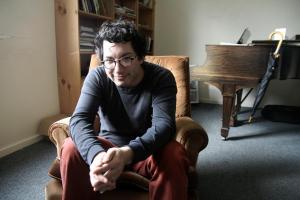 Matan came to Marlboro after four years as a lecturer at the University of Wisconsin at Whitewater. He received his D.M.A. degree from the University of Wisconsin, Madison, where his dissertation piece was a composition for electronic sound and large chamber ensemble entitled Le Invisibili. This work, a modular piece comprising 35 musical segments that can be combined 27,300 ways, was the culmination of a decade of creating musical compositions that can be radically different with every performance.
Matan came to Marlboro after four years as a lecturer at the University of Wisconsin at Whitewater. He received his D.M.A. degree from the University of Wisconsin, Madison, where his dissertation piece was a composition for electronic sound and large chamber ensemble entitled Le Invisibili. This work, a modular piece comprising 35 musical segments that can be combined 27,300 ways, was the culmination of a decade of creating musical compositions that can be radically different with every performance.
Matan brings a wide range of talents and experiences to Marlboro and is a prolific composer of music that is diverse in practice, medium and method. He is a frequent collaborator with artists in other disciplines, and he often makes music for dance and film. Some recent examples include Palimpsest for trombone and “tape,” commissioned by trombonist Michael Dugan; Knotcracker, commissioned by the Li Chiao-Ping Dance Company; and the score for Verge, a dance film directed by Douglas Rosenber. Matan is an active performer, having founded both the Sada Jazz Trio and the Modular Music Ensemble, and has several recordings to his credit. He is also a passionate teacher with interests that span many disciplines.
“Teaching music is the best way I know of to prove the infinite ways in which people conceive of and hear music,” he said. “Every time I teach a piece of music, someone brings a distinctly different way of hearing it. I can never be bored with my vocation this way.”
Marlboro’s interdisciplinary approach similarly resonates with new writing professor Kyhl Lyndgaard. “When I saw the titles of recent Marlboro course offerings and student Plans, I was amazed at how diverse and vibrant the academics were,” said Kyhl, who also joined the community in September. “My initial pleasure in learning about Marlboro gave rise to a strong desire to be amidst those catalog listings. This was a chance to challenge disciplinary boundaries on a daily basis and join a community that is built around flexibility of inquiry.”
 Kyhl came to Marlboro from Luther College, in Iowa, where he spent a year as an Associated Colleges of the Midwest–Mellon postdoctoral fellow in English and environmental studies. He received his Ph.D. in English with an emphasis in literature and environment from the University of Nevada at Reno. His dissertation, titled “Landscape of Removal and Renewal: Cross-Cultural Resistance in 19th-Century American Captivity Narratives,” is currently under review by the University of Oklahoma Press. It examines a handful of subversive Indian captivity narratives published in the 1820s and 1830s that challenge Indian Relocation Act policies and depict the frontier wilderness as a domestic and inhabited space. Kyhl also co-edited an anthology entitled Currents of the Universal Being: Explorations in the Literature of Energy, which had its genesis in a student seminar, forthcoming from Texas Tech University Press. He has written many articles and chapters on literature, writing pedagogy and the natural world, as well as reviews, nonfiction and poetry.
Kyhl came to Marlboro from Luther College, in Iowa, where he spent a year as an Associated Colleges of the Midwest–Mellon postdoctoral fellow in English and environmental studies. He received his Ph.D. in English with an emphasis in literature and environment from the University of Nevada at Reno. His dissertation, titled “Landscape of Removal and Renewal: Cross-Cultural Resistance in 19th-Century American Captivity Narratives,” is currently under review by the University of Oklahoma Press. It examines a handful of subversive Indian captivity narratives published in the 1820s and 1830s that challenge Indian Relocation Act policies and depict the frontier wilderness as a domestic and inhabited space. Kyhl also co-edited an anthology entitled Currents of the Universal Being: Explorations in the Literature of Energy, which had its genesis in a student seminar, forthcoming from Texas Tech University Press. He has written many articles and chapters on literature, writing pedagogy and the natural world, as well as reviews, nonfiction and poetry.
“An essay I’m planning to read at a conference in Alaska next summer will somehow combine Hurricane Irene, Thoreau’s Maine Woods, climate change and ideas of freedom and community in early and present-day America,” said Kyhl. “This list of topics suggests that Marlboro’s interdisciplinary approach to academics has influenced me already.”
Kyhl believes that good writing depends on confidence and the freedom to speak your own mind, and he creates a classroom environment that fosters a sense of personal responsibility
“Individuality in thought and expression is all too rare and undervalued these days, and I can’t imagine working anywhere but a small liberal arts college,” he said. “Marlboro’s small size is a real asset in forging the sorts of alliances and creative solutions needed to offer flexibility in student tutorials and Plans.”
Kyhl’s choices in course readings often emphasize literature that has inspired action. Dan Phillippon’s Conserving Words, for example, traces how nature writers have directly influenced the creation of environmental groups, as in the case of John Muir and the Sierra Club or Mabel Osgood Wright and the Audubon Society. “Teaching literature that has had direct and often measurable influences on policy and public attitudes shows students the power of language,” Kyhl said.
Both Kyhl and Matan are already active participants in the Marlboro community. Matan jumped immediately into participating in Town Meeting, giving the traditional annual plea for driving carefully on South Road, and played Copland and Gershwin processionals for Convocation. Kyhl led a group of students to do hurricane relief work for Marlboro residents on Augur Hole Road, and hit the go-ahead home run in the faculty-student softball game. The community welcomes these additions, and looks forward to their many and varied contributions to come.
Marlboro Returns to Cambodia
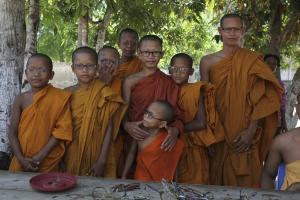 Last May, Marlboro community members took part in the second service-learning trip to Cambodia in the past three years, building on relationships from the last visit and forging new ones. For two weeks, art faculty John Willis and Cathy Osman as well as Max Foldeak, director of health services, were joined by seven students as they visited communities, participated in ESL classes in local schools and helped with water projects.
Last May, Marlboro community members took part in the second service-learning trip to Cambodia in the past three years, building on relationships from the last visit and forging new ones. For two weeks, art faculty John Willis and Cathy Osman as well as Max Foldeak, director of health services, were joined by seven students as they visited communities, participated in ESL classes in local schools and helped with water projects.
“Going to Cambodia completely changed the way I look at the world, and specifically the way I look at America,” said senior Nick Rouke. “It was the first time I had left the country, and it was incredibly difficult. It made me realize what I take for granted.”
Before their trip, the group initiated a community-wide auction of paintings, prints, photos, books, ceramics and other artwork created by students and faculty to raise $2,500 in aid for organizations in Cambodia. They also brought children’s books, medications and medical equipment, including nearly a thousand pairs of eyeglasses, donated from many local sources, as well as 30 laptop computers donated by Pfizer, Inc. Donations were processed through the World Peace Fund and the Amherst/Cambodia Water project. In-kind donations were brought by the group directly to schools in Kampong Chhnang, Ang, Pursat, Omani, Siem Reap and other communities where they participated in service projects.
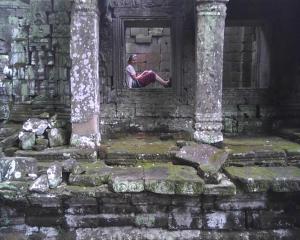 In addition to their work in communities, the group from Marlboro visited the capital of Phnom Penh, the temples at Angkor and memorials to those killed during the Khmer Rouge period.
In addition to their work in communities, the group from Marlboro visited the capital of Phnom Penh, the temples at Angkor and memorials to those killed during the Khmer Rouge period.
“We visited Tuol Sleng, a school that Pol Pot converted into a prison where he tortured and killed people,” said Nick, who had previously studied captivity and totalitarian regimes in other contexts. “People would be killed for disagreeing, much like the purges during the Stalinist era. It was very difficult to be there, but it made me really think about the things I have studied during my time here at Marlboro, why they are important to me, and what I want to do about it.”
Marlboro responds to flood damage
The Marlboro community will not soon forget the day in late August when Tropical Storm Irene destroyed local roads and cut the college off from the rest of the world for days. But perhaps more remarkable than the college’s resilience during and after the storm was the response to neighboring communities where the flooding wreaked even more havoc.
As early as September 3, just a week after the storm, a group of 21 Marlboro students and staff participated in the United Way Day of Caring. This was an event planned long before the flooding, and most of the projects for large groups did not directly involve flood relief. However, the outpouring of support was essential to the nonprofits that provide much-needed programs in the region, and a boon to the local efforts of the United Way. Marlboro students helped scrape and paint facilities at Green Mountain Girls Camp in Dummerston, Farming Connections in Guilford and Living Memorial Park Snow Sports in Brattleboro. Several students helped at Glen Park, on Western Avenue, a mobile home park for elderly residents that was damaged by floodwaters.
“It was one of the toughest, nastiest jobs anyone has had to face,” said Christine Forbes, whose 95-year-old mother, Alice Joslin, was one of the Glen Park residents helped by students. “Not only was the job completed, but they were so pleasant to her and made the job almost fun. I will long remember the happiness in her voice when she talked about these students. They were truly extraordinary young folks.”
The following weekend, as most of the local roads became passable, Marlboro’s new writing professor, Kyhl Lyndgaard, led a group of three students and one parent of a former student to the hardest-hit road in Marlboro, Augur Hole Road. There they helped remove silt from the residence that was once the Branch Schoolhouse.
“For all of us, the storm was a new and shocking experience,” said Kyhl. “But the washed-out roads have been more than matched by the resilience of Marlboro residents.”
On September 24, more than 70 students, faculty and staff joined together at Whittemore Theater to be part of the world’s largest poetry reading, 100,000 Poets for Change, an event that brings poets and other artists together to perform simultaneously around the world. The local effort, which directly supported United Way disaster relief and benefited victims of the storm, featured readings and performances by receptionist Sunny Tappan ’77, writing professor John Sheehy, senior Gina Ruth and junior Jack Rossiter-Munley, who organized the evening. It also included a silent auction and bake sale, and altogether raised more than $700 for local flood relief efforts.
Finally, a fund drive that started as a dare between two students ended with a total donation of $5,139 for the United Way of Windham County. When senior Anna Hughes offered to pay junior Chuck Pillette to dye his hair blue, they decided to up the ante and raise money for those affected by the flooding as well as others in need. Jodi Clark ’95, director of housing and residential life, was planning the traditional employee fundraising effort for the United Way when Anna asked for help getting her campaign going.
“It simply seemed like a great way to accomplish both the employee campaign and this student-led idea by combining them to make it a whole campus community campaign,” said Jodi. The resulting “Green for Blue” fund drive involved 17 prominent community members who promised to dye their hair blue if donations reached a certain level. While the campaign raised just $500 less than the goal of $5,000—the point at which Marlboro President Ellen McCulloch-Lovell pledged to go blue—a final push by faculty and students at the graduate school brought the total above that mark.
Events feature futuristic theater, Chinese cinema
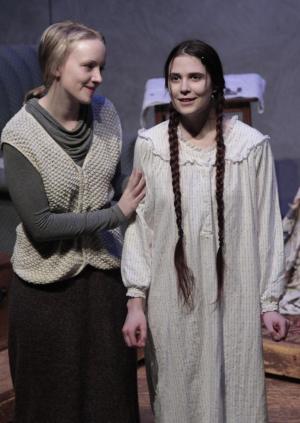 In November, the theater program presented two contemporary one-act plays by Caryl Churchill at Whittemore Theater, rounding out a full semester of events. The plays, Far Away and A Number, were directed by guest director Anna Bean, who worked with Marlboro students to present The Clean House last fall.
In November, the theater program presented two contemporary one-act plays by Caryl Churchill at Whittemore Theater, rounding out a full semester of events. The plays, Far Away and A Number, were directed by guest director Anna Bean, who worked with Marlboro students to present The Clean House last fall.
“This year I chose these two one-acts by Churchill, a British playwright whose work I find witty and chilling at the same time,” said Anna, who teaches at the Berkshire Arts and Technology Charter Public School and at Community College of Vermont in Bennington. “I saw both Far Away and A Number during their New York runs, and they have both haunted me with their tales of foreboding about the future. I thought I would see if we could create the same effect at Marlboro.”
Although both plays are set in the future, it’s a not-so-distant future that feels easily within reach. Far Away takes place in a post-apocalyptic world, where the heroine hat-maker negotiates her way, one precarious step at a time, while A Number centers around a father who made the choice long ago to clone his son.
“Both plays deal with themes of paranoia, war, fear—all of which are very present in our current culture,” said junior Kirsten Wiking, one of the students featured in the productions. Also included were sophomore Courtney Varga, sophomore Luc Rosenthal, junior Evan Lamb and freshman Luke Benning. “There’s a very real feel to the events in them, even if there are absurd elements,” continued Kirsten. “Because there’s a feeling of ‘this could be real,’ it was easy as a performer to tap into the fear or feeling of the events of the play.”
Also in November, the Asian studies program presented a weekend-long film festival titled Contemporary Landscapes of China. The six films showcased some of the best new films from China, including both features and documentaries, dealing with a range of contemporary social and environmental issues. For example, Before the Flood profiles people whose livelihoods are destroyed by the Three Gorges Dam, and Last Train Home documents the massive internal migration from China’s poorer inland provinces to the new industrial heartland. Each film was accompanied by a discussion led by authorities on the subject, including Asian studies professor Seth Harter, economics professor Jim Tober, Chinese language professor Grant Li and alumnus Tristan Roberts ’00.
For news about upcoming events, go to www.marlboro.edu/news/events.
A goddess slinks into eternity
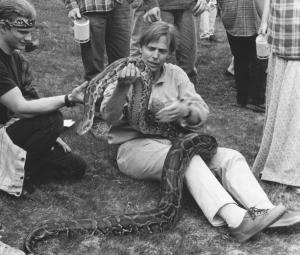 Those who frequent the science building are missing Kali, the 13.5-foot Burmese python, who passed away in September. Kali was six feet long when she was first introduced to the college 22 years ago by science faculty John Hayes and Jenny Ramstetter, despite the misgivings of their colleague Bob Engel.
Those who frequent the science building are missing Kali, the 13.5-foot Burmese python, who passed away in September. Kali was six feet long when she was first introduced to the college 22 years ago by science faculty John Hayes and Jenny Ramstetter, despite the misgivings of their colleague Bob Engel.
“Bob’s reservations gradually waned, and the python became a beloved resident of the science building among parrots, finches, turtles, lizards and exotic birds over the years,” said Jenny. “Bob and John named her Kali, after the Hindu goddess of destruction, and there were many jokes about how slacking Plan students might end up in the python area.”
Despite the jokes, Kali was a gentle soul who had many admirers and regular visitors: young kids from the community, surprised prospective students and of course devoted science students and faculty members. “Other translations of her Hindu name are more fitting: Kali, the ‘goddess of time and change’ and ‘goddess of eternal energy,’” said Jenny. “We will miss Kali.”
And more
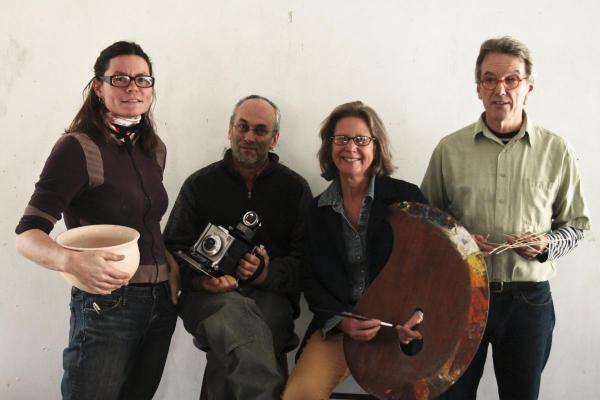
A group show at the Brattleboro Museum and Art Center, featuring new work by Marlboro art faculty Marina Lantin (ceramics), John Willis (photography), Cathy Osman (painting) and Tim Segar (sculpture), opened in November. Titled Four Eyes: Art from Potash Hill, the show will continue through February 5. Photo by Joanna Moyer-Battick
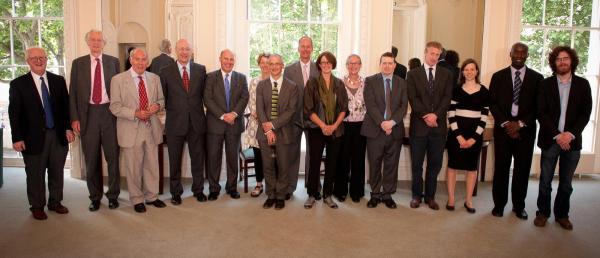
Last June, a few of Marlboro’s former Oxford classics fellows, math fellows and alumni gathered with Ellen McCulloch-Lovell, president, Ted Wendell, trustee, and Mary Wendell for a reunion at the British Academy in London. Those attending included (from left to right) Ted Wendell, Nicolas Barber, Geoffrey Fallows, Robin Jackson, David Middleton, former math fellow Charlotte Watts, ecologist Chris Carbone ’88, Robert Wendt, artist Pat Kauffman ’74, Ellen McCulloch-Lovell, Mark Pobjoy, Philip DeMay, Emma Park, former math fellow John Arhin and current classics fellow William Guast. Photo by Claudine Hartzel
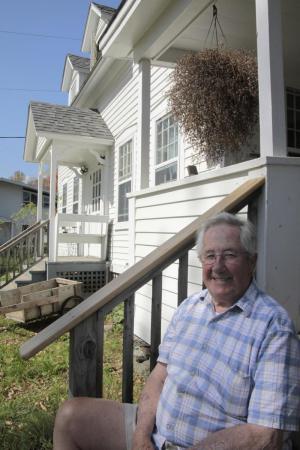 John MacDonald of Shaftsbury, Vermont, who was born in Hendricks House in 1927, stopped by the campus for a visit in October. His family owned 1,300 acres here and farmed and logged the land. After his father died, his mother, pregnant with twins, sold the farm to Marlboro founder Walter Hendricks and moved to the Northeast Kingdom. Photo by Dianna Noyes
John MacDonald of Shaftsbury, Vermont, who was born in Hendricks House in 1927, stopped by the campus for a visit in October. His family owned 1,300 acres here and farmed and logged the land. After his father died, his mother, pregnant with twins, sold the farm to Marlboro founder Walter Hendricks and moved to the Northeast Kingdom. Photo by Dianna Noyes
Worthy of note
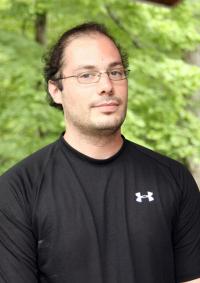 For those of us who dreaded making mistakes in math, the words of mathematics fellow Jean-Martin Albert (right) are a balm to the soul. “I want the students to fall into traps,” he said cheerfully, “to make mistakes and learn to see exactly where they made them and how to recover from them.” Jean-Martin’s enthusiasm for math shows that it can actually be fun, even useful. He received his M.Sc. in mathematics from the University of Calgary and is currently completing his doctorate in mathematics at McMaster University. Jean-Martin’s research interests are in mathematical logic, specifically something new and mysterious called continuous model theory and its applications to functional analysis.
For those of us who dreaded making mistakes in math, the words of mathematics fellow Jean-Martin Albert (right) are a balm to the soul. “I want the students to fall into traps,” he said cheerfully, “to make mistakes and learn to see exactly where they made them and how to recover from them.” Jean-Martin’s enthusiasm for math shows that it can actually be fun, even useful. He received his M.Sc. in mathematics from the University of Calgary and is currently completing his doctorate in mathematics at McMaster University. Jean-Martin’s research interests are in mathematical logic, specifically something new and mysterious called continuous model theory and its applications to functional analysis.
“I feel fortunate to be working at a place where I can just go and do some hands-on art sometimes,” said ceramics professor Martina Lantin. Last July, she and fellow art faculty member Cathy Osman attended a two-week silk-screening workshop at Haystack Mountain School of Crafts, in Maine. Martina was working on patterned, silkscreened wallpaper, to be used as part of her installation at the Brattleboro Museum and Art Center. “Having done plate installations on walls for many years, there is always the question of what lives behind the plates, and what is the relationship between the plates and wall. With the wallpaper, I see a conversation happening between the two.”
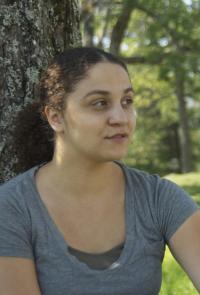 “Critical thinking is the bedrock of a functioning democracy and successful attempts to transform the world,” said social science fellow Renée Byrd (right), who is excited by Marlboro’s unique, student-driven approach to education. Renée received her bachelor’s degree in ethnic studies from Mills College, and is currently a Ph.D. candidate in feminist studies at the University of Washington. Her research focuses on contemporary prisons, neoliberal political rationalities and the politics of race, gender and sexuality. She has worked as a legal advocate for women prisoners in California and as a family advocate for youth involved in the juvenile justice system.
“Critical thinking is the bedrock of a functioning democracy and successful attempts to transform the world,” said social science fellow Renée Byrd (right), who is excited by Marlboro’s unique, student-driven approach to education. Renée received her bachelor’s degree in ethnic studies from Mills College, and is currently a Ph.D. candidate in feminist studies at the University of Washington. Her research focuses on contemporary prisons, neoliberal political rationalities and the politics of race, gender and sexuality. She has worked as a legal advocate for women prisoners in California and as a family advocate for youth involved in the juvenile justice system.
Once again, Spanish professor Rosario de Swanson confirmed for us that Spanish language, culture and literature have much to offer. In October, Rosario received the Victoria Urbano Award in drama, presented by the Asociación Internacional de Literatura y Cultura Femenina Hispánica (AILCFH) for her play titled Metamorphosis before the Obsidian Mirror: Monologue in Two Acts. She also presented a paper in September at an international conference at Howard University called “Africa and People of African Descent: Issues and Actions to Re-Envision the Future.” Her paper, “Dance as female affirmation in Ekomo, a novel from Equatorial Guinea,” was based on her recent research on Guinean literature (Potash Hill, Summer 2011, page 8).
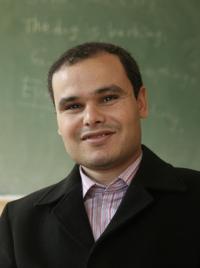 Fulbright Arabic Fellow Mohamed Jalal (right) considers the most exciting part of his fellowship the “nice and welcoming people.” This is a good thing, as it was a bit of a shock to come from the bustling port city of Mohammadia, Morocco, to a relatively quiet outpost like Marlboro. Mohamed received his bachelor’s degree in English studies from the Hassan II University of Mohammadia. Since then he has taught English in Mohammadia, most recently at the American Language Center. In addition to teaching Arabic, Mohamed has a strong interest in linguistics. After Marlboro, he hopes to continue teaching Arabic in the U.S. while he prepares for a Ph.D. program in applied linguistics.
Fulbright Arabic Fellow Mohamed Jalal (right) considers the most exciting part of his fellowship the “nice and welcoming people.” This is a good thing, as it was a bit of a shock to come from the bustling port city of Mohammadia, Morocco, to a relatively quiet outpost like Marlboro. Mohamed received his bachelor’s degree in English studies from the Hassan II University of Mohammadia. Since then he has taught English in Mohammadia, most recently at the American Language Center. In addition to teaching Arabic, Mohamed has a strong interest in linguistics. After Marlboro, he hopes to continue teaching Arabic in the U.S. while he prepares for a Ph.D. program in applied linguistics.
In an editorial published in The Commons, religion professot Amer Latif called for love, compassion and peace on the 10th anniversary of the 9/11 attacks. “As a Muslim-American, I find such inspiration in the life of the Prophet Muhammad, who, when asked how one could change the behavior of one’s children, replied, ‘Start with yourself,’” wrote Amer. He says that seeing all suffering equally is difficult work, work that begins with finding compassion within oneself. Amer also gave a series of talks at the Centre Congregation Church in Brattleboro on the intersection of Abrahamic faiths, as well as the keynote speech at the meeting of the Windham Union Association of UCC churches, “Understanding Islam through the words of Jesus.”
For those who think of terraces as nice places to grow rice or sip wine, math professor Matt Ollis has news for you. “A terrace is a structured pattern that might or might not exist in each of infinitely many mathematical objects called groups,” he said mysteriously. A recent issue of the Australasian Journal of Combinatorics includes a joint paper by Matt and former student Devin Willmott ’11 titled, “On twizzler, zigzag and graceful terraces.” “There are three somewhat separate problems addressed in the paper, tied together through their use of terraces,” said Matt. Devin collaborated with Matt on this paper as part of his Plan of Concentration on group theory.
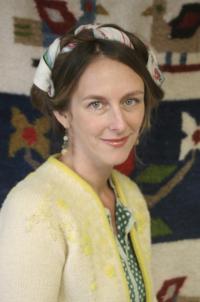 Marlboro students know Desha Peacock (right) as the director of career development, someone who can connect them with their next job prospect or internship. But Brattleboro knows her for The Desha Show, an eclectic human-interest show she produces on Brattleboro Community Television. In September, Desha received BCTV’s Best New Producer of the Year award, a great vote of confidence for her creative work. “The Desha Show is about beauty and inspiration, both inside and out,” she said. The show combines interviews with people who are living their dream with segments showcasing the work of “artists, interior designers, fashionistas and other creative types.”
Marlboro students know Desha Peacock (right) as the director of career development, someone who can connect them with their next job prospect or internship. But Brattleboro knows her for The Desha Show, an eclectic human-interest show she produces on Brattleboro Community Television. In September, Desha received BCTV’s Best New Producer of the Year award, a great vote of confidence for her creative work. “The Desha Show is about beauty and inspiration, both inside and out,” she said. The show combines interviews with people who are living their dream with segments showcasing the work of “artists, interior designers, fashionistas and other creative types.”
Continuing with her interdisciplinary research in disability studies, theater professor Brenda Foley presented a paper in September at a conference called “Chronic Illness: The Borderlands Between Health and Illness,” in Oxford, England. Her paper, “Passing Strange,” explores the ways we impose an unspoken cultural mandate that individuals with disabilities conceal their pain. “People with disabilities hide their pain, and the conditions that accompany it, behind carefully constructed presentational facades calibrated to suppress physical and emotional trauma,” said Brenda.
When visiting painting professor Craig Stockwell joined Marlboro for the fall semester, it was a bit of a family homecoming. The first settler of Marlboro in 1763 was Abel Stockwell, Craig’s great-great-great (etc.) grandfather, who died in 1777 of the “black fever” and is buried in the woods of Marlboro. “I have found it profoundly moving and intriguing to return to this hill town after so many generations,” said Craig, whose great-grandfather left the area in the 1800s to move to Massachusetts. The founder and artistic director of Artworks of Keene, as well as an adjunct professor at both Keene State College and Union Institute and University, Craig also served as a visiting artist in 2004 and as an outside examiner for several Marlboro students.
During her fall semester sabbatical, painting professor Cathy Osman spent time in the studio on a series of works that are collage based, using old sewing-pattern tissue layered with marks and patches of color. “Some of the new work can be read as landscape, reflecting the flood waters of the past month, or as an image complex with a scaffolding, referencing industrialization and chaos,” said Cathy. Some of the pieces include constructions of balsa wood that evoke broken bridges, fish netting or window blinds. “They have a sculptural presence on the wall, but also a fragility—the tissue paper is skin-like and the balsa wood weightless, giving the work a sense of impermanence—issues which are current to me now.”
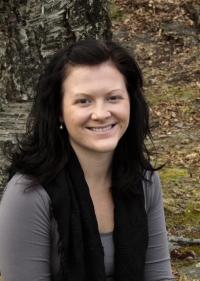 “Social and professional networking is dramatically changing how people look for jobs and prepare for interviews,” wrote student life coordinator Zoe Ogilvie (right) in the September/October issue of InChemistry. In an article titled “Upgrading Your Online Image,” co-authored with Lisa Marshall, she describes how to make the digital transition from college student to scientific professional. Zoe, who received her master’s degree in media and professional communications from Fairleigh Dickenson University, works for the career development office at Marlboro. In her article she shares sage advice and specific strategies useful to prospective employees in any field, including avoiding faux pas like sharing inappropriate photos or badmouthing previous employers.
“Social and professional networking is dramatically changing how people look for jobs and prepare for interviews,” wrote student life coordinator Zoe Ogilvie (right) in the September/October issue of InChemistry. In an article titled “Upgrading Your Online Image,” co-authored with Lisa Marshall, she describes how to make the digital transition from college student to scientific professional. Zoe, who received her master’s degree in media and professional communications from Fairleigh Dickenson University, works for the career development office at Marlboro. In her article she shares sage advice and specific strategies useful to prospective employees in any field, including avoiding faux pas like sharing inappropriate photos or badmouthing previous employers.
Alumni News

Class notes are listed by year and include both graduates and nongraduates; the latter are listed under the class with which they are associated.
’59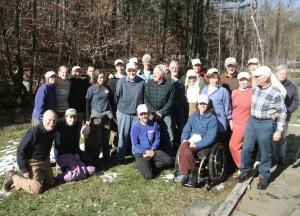 “The college has joined with Marlboro Cares,” BARBARA and BRUCE COLE write, “a local volunteer organization that provides various types of assistance to Marlboro residents, to jointly host a monthly luncheon for senior citizens in the campus center while college is in session. Many gather to reminisce, renew old friendships, see neighbors and get to be on campus. Irene’s flooding took its toll, especially on roads and our town of Wilmington. Slow recoveries, but Vermont is making it. Still enjoying Vermont’s seven seasons: winter, spring, mud, black fly, summer, fall and twig.”
“The college has joined with Marlboro Cares,” BARBARA and BRUCE COLE write, “a local volunteer organization that provides various types of assistance to Marlboro residents, to jointly host a monthly luncheon for senior citizens in the campus center while college is in session. Many gather to reminisce, renew old friendships, see neighbors and get to be on campus. Irene’s flooding took its toll, especially on roads and our town of Wilmington. Slow recoveries, but Vermont is making it. Still enjoying Vermont’s seven seasons: winter, spring, mud, black fly, summer, fall and twig.”
’63
JONATHAN POTTER writes that he recently published a couple of new plays: “Check Amazon.”
’69
JOHN DEVANEY exhibited his paintings at Robert Foster Fine Art on Nantucket in August.
’70
DAN DALY still has his real estate license in order to help his wife, who is a fulltime broker. “Most of the time I paint landscapes and studies of everyday objects. I’m also very active in conservation work and just finished a tenure as state chairman of the Maine Council of Trout Unlimited. Stop by if you’re in mid-coast Maine.”
’71
ROBERT HULLOT-KENTOR is now the chair of a new master’s program, Critical Theory and the Arts, at the School of Visual Arts in Manhattan.
“Both PAUL and I are retired, but working part time,” writes CATHIE WILLIS. “Paul is working at the local post office two days a week, and I am doing some consulting work and working as a substitute school nurse. We are traveling off to the Amazon and Machu Picchu in August, and then Tibet, Nepal and Bhutan in November.”
Elliot Gertel ’73: Twisted T-shirt of fate
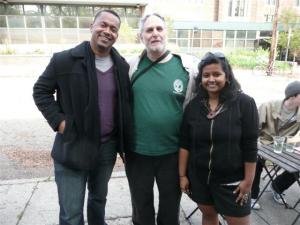 In October, I had a brunch date with friends at the Jefferson Market and Cakery in Ann Arbor, Michigan. For some reason, as I was getting dressed that morning, I decided for the first time in months to wear one of my Marlboro T-shirts under my long-sleeved shirt. After brunch, the five of us went outside and asked some people who were waiting for their food if one of them would take our picture. After the photos were taken, we had a nice chat with the young man who had kindly snapped our picture and his other dining companions.
In October, I had a brunch date with friends at the Jefferson Market and Cakery in Ann Arbor, Michigan. For some reason, as I was getting dressed that morning, I decided for the first time in months to wear one of my Marlboro T-shirts under my long-sleeved shirt. After brunch, the five of us went outside and asked some people who were waiting for their food if one of them would take our picture. After the photos were taken, we had a nice chat with the young man who had kindly snapped our picture and his other dining companions.
When our photographer mentioned that he and a friend who was visiting from Baltimore had both attended college in Vermont, I just knew right away which school it was. We realized we were all graduates of one of America’s smallest colleges while standing in the town with one of its far larger ones, the University of Michigan. After exchanging hugs, we posed for a photo to commemorate this historic moment and amazing coincidence. I had momentarily forgotten that I had on my Marlboro t-shirt, so we took another shot when I recalled what I was wearing: yet another incredible and perhaps psychic twist of fate.
My fellow Marlboro alumni were Carlus “Max” Henderson ’09, who took our picture and who is now a graduate student instructor in the creative writing program here at the University of Michigan, and Kareshma Mohanty ’09, who currently resides in Baltimore. Who could have ever imagined this unbelievable, unplanned alumni meeting?
’75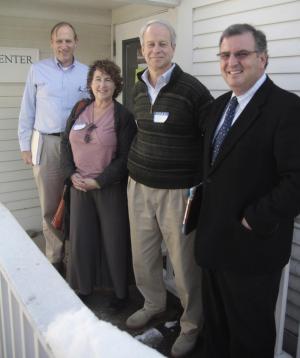 Zulu Fits, a play by ALONZO LAMONT, opened at Load of Fun Theater in Baltimore as part of the Baltimore Playwrights Festival in August. Produced by Heralds of Hope Theater Company and directed by Lonnie, the play tells the story of two teenage sisters, NeeCee and Giselle, who intend to rescue a very popular black political prisoner—Jersey Jack Black—from prison. Fancying themselves as teenage terrorists, they raise money through their website, where they pose in provocative attire, take in donations and acquire a large cyber following. Running along parallel lines is the history of NeeCee and Giselle’s new family home, formerly the property of Patty Cannon, a white woman who captured free black men, women and children and resold them to southern slave owners. Ultimately, the play asks why society falls for “the sexy pick” as opposed to the legitimate, very real history that is often ignored.
Zulu Fits, a play by ALONZO LAMONT, opened at Load of Fun Theater in Baltimore as part of the Baltimore Playwrights Festival in August. Produced by Heralds of Hope Theater Company and directed by Lonnie, the play tells the story of two teenage sisters, NeeCee and Giselle, who intend to rescue a very popular black political prisoner—Jersey Jack Black—from prison. Fancying themselves as teenage terrorists, they raise money through their website, where they pose in provocative attire, take in donations and acquire a large cyber following. Running along parallel lines is the history of NeeCee and Giselle’s new family home, formerly the property of Patty Cannon, a white woman who captured free black men, women and children and resold them to southern slave owners. Ultimately, the play asks why society falls for “the sexy pick” as opposed to the legitimate, very real history that is often ignored.
’76
“We’re half empty nesters now,” MELISSA METTLER ABRAMS writes. “Our daughter Haley went off to college in the fall. Our other daughter, Clare, is a sophomore in high school, so we still have a few years with her. We bought a new house last year and are finally getting settled in.”
’77
SUNNY TAPPAN continues to love her job as the Marlboro College receptionist. “I can’t imagine working anywhere else. I am proud of my education here, of my Planwork and all that I’ve learned here since graduating. The learning never stops.”
LAURA LAWSON TUCKER writes, “It was such fun to return to campus last fall to teach a class for Ken Schneck on community performance. Two of his students interned with me at the New England Youth Theater.” (See Potash Hill, Winter 2011.)
’78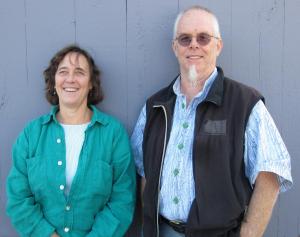 “Re-starting the art career after raising two kids,” writes NAT SIMKINS. “Will be in two shows on the North Shore this fall, at Art in the Barn and the Crane Estate show and sale.”
“Re-starting the art career after raising two kids,” writes NAT SIMKINS. “Will be in two shows on the North Shore this fall, at Art in the Barn and the Crane Estate show and sale.”
’80
“Just a quick note to say that I finally went to the Grand Canyon,” writes DIANNA NOYES. “Wow.”
MAUREEN TADLOCK’s memoir, The Weakness of Gravity, was published by AuthorHouse last spring.
’81
CHARLIE CHIARA writes from Pasadena, California, “For the past six years I have been a partner at Clear Stream Media Group, where I have been making films and media clips for a variety of businesses, community service organizations and charities. We have clients throughout the U.S., so I get to travel a bit and have journeyed to India twice for our client Organic India and to Italy once with Study Abroad Italy. You can learn more about what we are doing and watch a few films by going to our website at www.clearstreammg. com. If you need a film to promote your business or charity, give me a call. I would love to talk about your project. And of course, I have a special price for Marlboro people. Prior to forming Clear Stream Media, I spent 20-plus years in the entertainment business, including working with Image G, a motion control (computerized cameras) house filming models for Star Trek: The Next Generation. That was a hoot. I also worked at Dinamo Entertainment, where I was on a team developing feature films including The Substitute, Suicide Kings, The Arrival and Lost & Found. From 2000 to 2003 I tried my hand at being an independent producer, producing a pilot for an animated kids show, Speed-Quest. I thought it was great and so did my kids, but I was ultimately unable to secure a decent deal for the series so it went on the shelf. (Hmm, maybe I should send it out, with a new title, of course.) In 2004 I got back to work and joined my friend producer Jim Hart as the postproduction supervisor for the short-lived FOX comedy Cracking Up, starring Molly Shannon and Jason Schwartzman. I created Clear Stream Films as a media supplier to Cracking Up, and it turns out to have had staying power. Go figure. For my community service, I work with Teamwork Foundation/New York Gauchos and was named president of the board in 2007. Teamwork/Gauchos runs an after-school basketball programs for over 400 boys and girls in the Bronx. In the program’s 44-year history, our players have received over 500 years of college scholarships for free, while 24 of our kids have become NBA or WNBA players, including the star of last year’s men’s Final Four, UConn’s Kemba Walker. My wife Rene and I have been married for almost 19 years, and we have three children: Julian (16), Lucas (14) and Sophie (11). I will tell you about them the next time.”
“Still living the good life on the coast just south of San Francisco,” NOBBY RIEDY writes. “My wife, 6-year-old daughter and I are enjoying the wonders of elementary school, gardening, wilderness and a beautiful rural life. If you are in the neighborhood, stop by for a visit.”
LLOYD KING writes, “After seven years in the burbs, BETH (TYLER ’83) and I bought an 1888 cottage on Chicago’s South Side. It’s right on the lake and about a mile north of the Obama mansion. Beth resigned her job as dean of students at Lake Forest College while she was at the top of her game. She wanted to find something less stressful. She recently accepted the position of executive director of retention initiatives at Indiana University Northwest in Gary, shifting her workplace from one of the richest towns in the country to one of the poorest. She loves the change. After three years with public radio, I took a gig as career adviser in the arts for the University of Chicago. Get to ride my bike to work. Still playing in Funkadesi and a few other bands. Still broadcasting, only shorter and sweeter—@lloydbking. Still hanging out with Marlboro peeps. CAROL MURPHY ’85 and PETER NIEWIAROWSKI ’84 just visited with their 13-year-old, Remik. A few weeks ago JOHN POPLETT ’80 and I occupied Chicago. In December we’ll be visiting JOHN GRAY ’78 in New York City. Old friends are the best.”
’82
PETER KLANK is serving on the board of directors of Friends of Writers, Inc., the nonprofit partner to the Warren Wilson College MFA Program for Writers. “I will also be running the Friends of Writers 2012 Annual Post-MFA Writing Conference, which will be held this year at Mt. Holyoke College.”
DAN PICKER writes, “This past spring I published two prose works. My memoir of studying with Seamus Heaney at Harvard appears in The Oxonian Review of Oxford University, where I also studied. In addition, another book review of mine has been published in Rain Taxi Review of Books. My poems are forthcoming in Shampoopoetry.com of San Francisco, which has published at least one other Marlboro College alumni poet, and in Vermont Literary Review. I enjoyed lunch with JIM WADE in Princeton.”
’83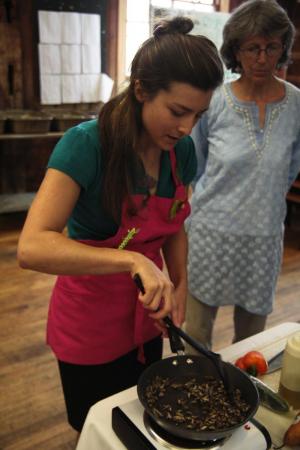 BEN SARGENT and MARY LIN ’87 (nee Iacobucci) debuted scenes from their second opera, a commissioned Steampunkian farce a la Mozart by way of Gilbert and Sullivan, at the Great New England Steampunk Exposition in Fitchburg, Massachusetts, this past September. MOLLY CONOLE ’84 and BARBARA HILLIARD ’87 helped with sets, props and videography. Photos and video are posted—you’ll find links at inventingearth.org, the nonprofit arts organization that Ben and Mary founded last year.
BEN SARGENT and MARY LIN ’87 (nee Iacobucci) debuted scenes from their second opera, a commissioned Steampunkian farce a la Mozart by way of Gilbert and Sullivan, at the Great New England Steampunk Exposition in Fitchburg, Massachusetts, this past September. MOLLY CONOLE ’84 and BARBARA HILLIARD ’87 helped with sets, props and videography. Photos and video are posted—you’ll find links at inventingearth.org, the nonprofit arts organization that Ben and Mary founded last year.
’86
“Life in the sunny Pacific Northwest continues to be full of fun and adventure,” writes TOM GOOD. “Most of it happens on the living room floor, where Beth and I are entertained by son Porter (3.5 years) and daughter Hadley (0.8 year). I passed the 10-year mark at NOAA Fisheries this year, and I continue my work on a variety of projects focusing on marine ecology and seabird-fisheries interactions at the Northwest Fisheries Science Center in Seattle. Some of my research takes me into the field and onto uninhabited islands, where I find myself catching my breath, staring out on the Pacific Ocean and marveling at my good fortune. I recently had coffee with Jessica Nelson from the admissions office, who had an afternoon free while visiting schools from Seattle to Portland. It was fun to chat about the college, and I found it comforting that while some things at Marlboro are ever-changing, other core things never change. It gives me faith in the future of the college as well as my ability to represent the school when talking to my interns and other students I meet about life at Marlboro. I’ll never forget my visit in January 1981: TOM DURKIN ’79 was admissions counselor and gave me a tour that included showing off the view from the library porch, popping in on VINCE RIBAS ’82 and SAUL GRESSER ’85 shooting pool in the Happy Valley common room, and ending with experiencing lunch in the dining hall on one of those days where the windows are steamy and the conversations are energized. I was hooked. We get back to northern New England for annual family visits and hope to swing by Marlboro one of these years.”
’87
TETA HILSDON writes, “Since I never send news to Potash Hill, I thought maybe I’d say hello to all my old classmates with a quick snapshot of life. I’ve lived in the Brattleboro area ever since leaving Marlboro, but even 34 years doesn’t make one a native. My son, however, is indeed a native. He’s 27, and after traveling the world and living in many other places, he circled back and is living and working in Brattleboro, doing solar installations with Soveren. That’s particularly apt since his father and I met when we each worked for solar companies in 1983. These days I do administrative work at the Brattleboro Museum and Art Center, and I have my pottery business on the side. I own a little house in Brattleboro and live with my partner, Steve Procter. Call me, old classmates, if you’re passing through Brattleboro and need a good couch: (802) 246-7034.”
Sarah Edwards ’88: Taking budget priorities to Washington
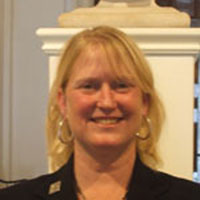 In September, Brattleboro lawmaker Sarah Edwards was honored with an award for her contributions to sound progressive policies at a Washington, D.C., conference titled “Women at the Table of Power.” A state representative on the Progressive/Democrat ticket, Sarah was presented with the 2011 Pacesetter Award from the Women Legislators’ Lobby (WiLL), a Washington-based network of women state legislators.
In September, Brattleboro lawmaker Sarah Edwards was honored with an award for her contributions to sound progressive policies at a Washington, D.C., conference titled “Women at the Table of Power.” A state representative on the Progressive/Democrat ticket, Sarah was presented with the 2011 Pacesetter Award from the Women Legislators’ Lobby (WiLL), a Washington-based network of women state legislators.
“It is wonderful to be recognized for one’s work. It gives you encouragement to continue,” said Sarah. The “Women at the Table of Power” conference provided women lawmakers the opportunity to network with policy activists and to find common ground on education and economic issues. Sarah, who has been a member of WiLL for eight years, was recognized for her efforts to change national priorities, and especially for her focus on the defense budget.
“Pentagon spending all too often funnels billions of dollars toward outmoded weapons that were originally intended to fight the Cold War,” said Sarah. “We can pinpoint extremes in wasteful expenditures that do nothing to make us safer. Redirecting those dollars into education, health, transportation and infrastructure can provide the jobs and services that are desperately needed in communities across Vermont and America. We cannot afford to stand on the sidelines for this debate.”
’94
“Hello from Nantucket,” writes TIMALYNE FRAZIER. “Recently, I was accepted into the Artists Association of Nantucket (www.nantucketarts.org) for photography. I will have my photography available on SmugMug soon. I intend to apply for oil painting as well, this October. It was a treat to discover that a fellow AAN member, whose work I have admired for some time, is also a fellow Marlboro alumnus, JOHN DEVANEY ’69 (http://johndevaney.com/home.html). We spent some time remembering many of the same Marlboro professors, even though our stints at Marlboro were a bit apart. I received my master’s in liberal studies from Reed College in Portland, Oregon, in 2009. For my senior thesis project, I wrote a body of poetry and a complementary critical paper. Phoebe started middle school this year, and Chloe is in the third grade. Paul is working toward his wastewater license as a Town of Nantucket employee, and I’m a legal assistant at Reade, Gullicksen, Hanley & Gifford, LLP. My friend Rob lives with us as the nanny and helps us manage the kids and the house. We have a dog, Pogo, and only three cats. I can see the ocean from my bedroom. My heart goes out to Vermont with all the flooding and challenges lately, specifically to Marlboro and Brattleboro, two places I have counted as home for seven years of my life.”
Jodi Clark ’95: Putting life into residential life
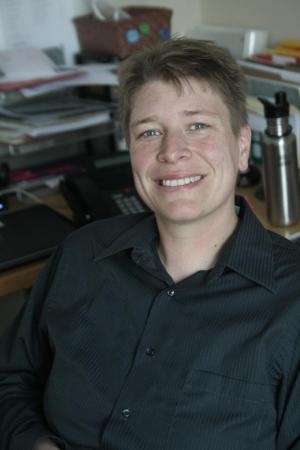 Members of the Marlboro community were pleased to return in the fall to find our own Jodi Clark in the position of director of housing and residential life. Before returning to campus, Jodi was the program coordinator for ActingOut, an improvisational theater-training program for adolescents in the Monadnock region of New Hampshire. She also worked on a number of community-based initiatives that strive to increase wellness through substance abuse prevention, nutrition and other health support.
Members of the Marlboro community were pleased to return in the fall to find our own Jodi Clark in the position of director of housing and residential life. Before returning to campus, Jodi was the program coordinator for ActingOut, an improvisational theater-training program for adolescents in the Monadnock region of New Hampshire. She also worked on a number of community-based initiatives that strive to increase wellness through substance abuse prevention, nutrition and other health support.
“Being part of wider community problem-solving initiatives gave me more experience addressing various angles of larger issues in a committee or coalition setting,” said Jodi. “I enjoy being able to serve Marlboro with what I have learned working in the Monadnock region, in addition to simply being part of a community that is near and dear to me.”
Jodi, who was employed as a student life advisor from 2001 to 2006, finds that Marlboro now has many more systems in place to serve the community. “I see a lot more programming in many arenas because there are more people able to help facilitate them. My previous work at Marlboro taught me to think on my feet, flow with a situation and know that because I have a great team, we will work through even the most complex, strange or challenging situations together.”
’98
SHAW IZIKSON is “currently a reporter and photographer at The Winsted Journal— www.tricornernews.com/winstedjournal—still fighting the good fight for college loan reform. And I am the group moderator of the M.C. Alumni Facebook group at https://www.facebook.com/groups/marlborocollegealumni/ and the LinkedIn group at http://www.linkedin.com/groups?gid=85402&trk=hb_side_g.”
“I’m FINALLY studying in the professional training program at the Lecoq School in Paris,” writes AARON KAHN. “It was in 1996 at Marlboro that Eric Bass suggested I look into the school, and I have been looking for a way to make it happen ever since. Been living in Paris since 2007, learning French and getting established. Et voila! Merci Marlboro, et merci mille fois Eric...”
’01
KATE OSBORN has moved from New York City to Washington, D.C., where she is continuing to work for the same catering and events company, this time at the U.S. Senate. From their father, we learn that CARRIE STERR was married in her hometown of Vancouver, Washington, in July and then moved to Providence, Rhode Island, and that her brother, AMBROSE ’07, is working in internet marketing at Marchex in Seattle.
’02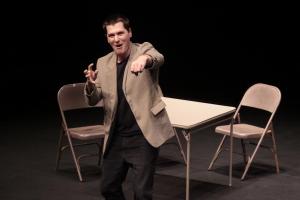 HEIDI PETERS is working at Hunger Mountain Co-op in Montpelier, Vermont.
HEIDI PETERS is working at Hunger Mountain Co-op in Montpelier, Vermont.
’04
ELIOT and ALLISON (LENNOX) GOODWIN joyfully welcomed a daughter, Stella, on May 19, 2011, in Cambridge, Massachusetts.
HEATHER BRYCE LABOR is working as an admissions counselor at Goddard College and started their master’s program in education this fall. She was the event coordinator and producer of Rising Above the Water, a benefit held at Goddard in early December that brought together 13 dance companies and choreographers from across the state to perform and raise money for Vermont Disaster Relief in the wake of Tropical Storm Irene. She was also married in May. “It’s certainly been an exciting year,” she writes.
’05
“I look back at my years at Marlboro all the time,” writes IVY ROBERTS. “It was a formative experience. I’m doing well, moving about, hopping from school to school, teaching and learning. I launched a website and am going for a Ph.D.”
’06
JOSIE DELMAN MOSSER writes, “Hey everyone. Five years ago in May, I graduated from Marlboro. Five years ago in September, Greg and I got married. Six days later, we hightailed it out of Vermont down to western North Carolina. Here are the last five years in a nutshell: I spent four and a half years as business and marketing director of a mental health organization offering equine assisted therapy. It was quite educational, learning how to run someone else’s company, earning the unofficial title ‘administrative octopus.’ This past July, in the course of a 30-minute meeting, I quit my job and hired my old boss as my first client. I am now self-employed, kind of flailing in the transition, and so happy with my decision. Greg and I have been playing sludge metal with JAMIE PAUL ’08 for almost two years down here—and that is awesome, to say the least. I was recently certified as a yoga instructor and will begin teaching classes this winter. My sister and I just finished a collaborative art project called ‘2012: The Last Calendar You’ll Ever Need.’ She inked the drawings, I painted them, then we created the calendar and self-published. You can find the calendars and me on my website, josiemosser.com. We’ve kept up our gardening and permaculture ways as best as we can without owning land. We are hooked on perennial tubers and are hoping to find a few favorites to cultivate and select from. We grafted 45 fruit trees last April, and at least half of them are thriving. (Grafting, in case you were wondering is like a combination of marriage and surgery.) Greg and I recently spent our fifth wedding anniversary becoming Viking- Hobbit warrior-explorers, canoeing up ancient tributaries of drowned mountains, and hunting wild American persimmons in the vast and mysterious Lake Fontana. In short: life is good, and we miss you guys.”
’08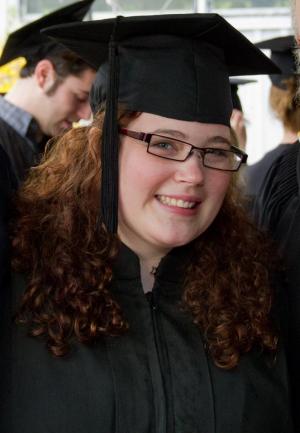 TOM DEVITO is currently teaching English in Panama, according to his mom.
TOM DEVITO is currently teaching English in Panama, according to his mom.
ERIC GUSHEE received a B.F.A. from the Art Institute of Chicago and is working as a sculptor in Chicago.
’10
WILL JENKINS worked at the Brattleboro Museum and Art Center for over a year before heading out to California to attend U.C. Berkeley’s doctoral program in history. “I’d love to meet up with other Marlboroites in the Bay Area,” he writes.
’11
ZACH PEARSON is living in Boston and playing guitar with the Gypsy jazz band Ameranouche and the chamber group Ensemble San Genevieve.
“I have a job,” exclaims KELLY PIERCE-BULGER. “It is as the development coordinator (fundraiser, basically, through AmeriCorps) with the Council on American-Islamic Relations. I am very excited to actually be working in my field of study. I will be working through AmeriC orps for the next year, but then hopefully I will have raised enough money to make my position permanent with CAIR.”
Former faculty news
In May, former computer science professor ADRIAN SEGAR was named one of the 68 Most Innovative People in Events by BizBash Media, a leading events-trade magazine. The author of Conferences That Work: Creating Events That People Love, Adrian was recognized for creating and championing participant-driven conferences for the last 30 years. “Bizarrely, I’m listed with the glamorous folks who organized Chelsea Clinton’s wedding and brands like IBM and Coca-Cola,” said Adrian. “I’m the only Vermonter in the list and the only New Englander outside Boston. Quite a transition from an ancient Ph.D. in elementary particle physics.”
For those of you who missed the retrospective show by artist and retired art professor FRANK STOUT a couple years ago (Potash Hill, Winter 2009), he has a new website that illustrates his talents at www.frankstout.com. “Over the decades, Frank Stout has produced a unique and timeless body of work,” said Mara Williams, chief curator at the Brattleboro Museum and Art Center. “With tender detail and monumental scope, his restless narrative images create a sweeping, eloquent album of life in the 20th century and beyond.”
Letters

Remembering J.K. Adams
It was both sad and enlightening to read about J.K.’s death (Potash Hill, Summer 2011). I had no idea about how he had spent his life after Marlboro. It was no surprise that he went on to be incredibly creative. I spent the summer after my freshman year living with J.K. and a somewhat rotating group of kids in what we called Halifax Jazz, a rundown house somewhere on the back road to Halifax. It was waist deep in debris when we got there, but we shoveled it out and made quite the home of it. Some of us were working for Halsey Hicks, traipsing through the forest with, literally, flowers in our hair (Stuart Spore). Others were waiting tables and providing us with leftover food from the restaurant. It was one of the most memorable summers of my life, and running all through it was J.K. Adams and his music. I remember driving down the dirt road with J.K. banging away at a piano in the bed of the truck. He literally provided the music of our lives that summer. What a loss to the world.
—John Atchley ’69
Going Digital
I just finished the most recent version of Potash Hill, in which there was a letter to the editor from Janet and Herman Schnurr that reminded me to write to you on the topic of receiving the magazine in paper format. Although I very much enjoy receiving it in the mail, I’ve been finding it much more convenient to simply download it for perusal on my laptop. In the additional interest of saving some trees and postage, it makes sense to ask you to stop mailing it out to me. Although html is great, I get much more from pdf versions of periodicals like Potash Hill because of their versatility. Thank you for producing both. Just please, please don’t stop publishing it.
—Brian Whitehouse ’91
Worth the Effort
Forty years ago this September I entered Marlboro College with joy in my heart. To this day, I do not know how or why I was admitted. According to my advisor, Alan Kantrow, the poetry I submitted in my application was so awful that he pleaded to the admissions committee that if I were accepted, the entire college would, or should, close in disgrace. As things turned out, he became one of my Plan advisors, and I keep up with him to this day. I write simply to say thank you to Roland Boyden, Dick Judd, T. Wilson and Alan for taking me under their wing. When I entered Marlboro, I could not write an English sentence properly. When I left, I had written a Plan worth the effort. All the credit goes to Alan and Roland and especially Dick. His expressive eyebrows and twinkling eyes always conveyed his deep love of scholarship and learning—and the sheer fun he was having as our teacher. I can still smell his pipe. I went on to earn degrees from Brown and from the Bread Loaf School of English, and I have taught English and history to high school students for over 30 years. Not a day goes by in my life as a teacher that I do not think of Marlboro. The college has a special place in an America too often impressed with appearance and status over substance.
—Terence Woods ’75
Tail-wags for Bob
Bob Engel was one of my Plan sponsors and my favorite teacher (Potash Hill, Summer 2011). I was not a naturally talented science student, just enthusiastic, and he was warm and helpful and patient with me. I regularly wound up in the green chair in his office with my shoes off and my legs tucked under me, talking out an issue or arguing sociobiology. My most enduring memory of Bob comes from a day when several of us drove to his house for a relaxed afternoon tutorial. He showed us into the greenhouse section and we all got comfortable. Then the phone rang, and when Bob got up to answer it, his little dog (the Basenji) jumped into his chair and curled up in his spot. When Bob returned, he took one look at the dog and sat on the floor. “Why don’t you move the dog?” I asked him. “Because he’s sitting there,” Bob said, as if to a slow child. It just didn’t occur to him to disturb the dog. I’ve always been an animal lover, but I learned a lesson that day, and when my cat stretches out on my bed, I curl up and give her room. I was extremely lucky to spend so much of my time at Marlboro with Bob Engel.
—Deborah Ratner FS ’94
Errata
I just wanted to mention that it seems one word was missing from the link on the last line of page 59 in the Summer 2011 Potash Hill. To read the full entry in the career development newsletter about Lisa Orenstein ’10, who’s in the Peace Corps in the Ukraine, go to www.marlboro.edu/communities/current/career.
—Anne Stevens, parent of Julianna Stevens ’12
After seeing so many college mags, and now receiving two others (from Earlham, our daughter’s alma mater, and Lawrence University, where our son begins this fall), I have to tell you I’m all the more impressed with the depth, design and originality of Potash Hill. It truly stands out and above all the others. Thanks for all you do to produce such a beautiful publication. Mom-in-law Fran Nevins emailed me today to say she saw mention of me in the alumni news (Potash Hill, Summer 2011) and one of the facts wasn’t right. I gather she’s referring to my location. I have long lived, wandered and worked to inspire a sense of place in Concord, Massachusetts—where the Minutemen, Thoreau and Emerson once roamed—not Concord, New Hampshire. No worries, the confusion must still be stuck in the ethers since Bachman’s slip-up.
—Cherrie Corey ’76
In Memoriam
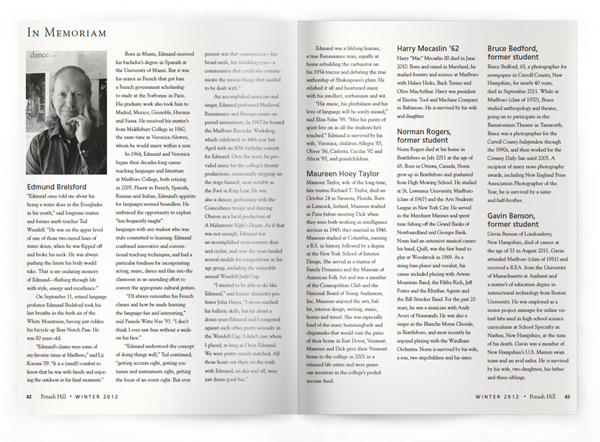
Edmund Brelsford
“Edmund once told me about his being a water skier in the Everglades in his youth,” said longtime trustee and former math teacher Ted Wendell. “He was on the upper level of one of those two-tiered lines of water skiers, when he was flipped off and broke his neck. He was always pushing the limits his body would take. That is my enduring memory of Edmund—flashing through life with style, energy and excellence.”
On September 11, retired language professor Edmund Brelsford took his last breaths in the fresh air of the White Mountains, having just ridden his bicycle up Bear Notch Pass. He was 80 years old.
“Edmund’s classes were some of my favorite times at Marlboro,” said Liz Korona ’09. “It is a (small) comfort to know that he was with family and enjoying the outdoors in his final moments.”
Born in Miami, Edmund received his bachelor’s degree in Spanish at the University of Miami. But it was his minor in French that got him a French government scholarship to study at the Sorbonne in Paris. His graduate work also took him to Madrid, Mexico, Grenoble, Havana and Siena. He received his master’s from Middlebury College in 1960, the same time as Veronica Alewyn, whom he would marry within a year.
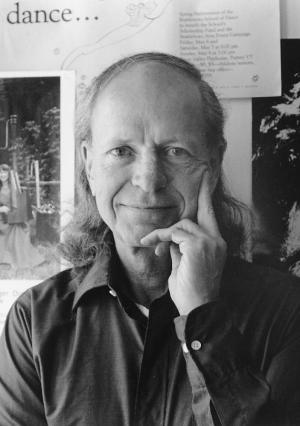 In 1964, Edmund and Veronica began their decades-long career teaching languages and literature at Marlboro College, both retiring in 2005. Fluent in French, Spanish, Russian and Italian, Edmund’s appetite for languages seemed boundless. He embraced the opportunity to explore “less frequently taught” languages with any student who was truly committed to learning. Edmund combined innovative and conventional teaching techniques, and had a particular fondness for incorporating acting, music, dance and film into the classroom in an unending effort to convey the appropriate cultural gesture.
In 1964, Edmund and Veronica began their decades-long career teaching languages and literature at Marlboro College, both retiring in 2005. Fluent in French, Spanish, Russian and Italian, Edmund’s appetite for languages seemed boundless. He embraced the opportunity to explore “less frequently taught” languages with any student who was truly committed to learning. Edmund combined innovative and conventional teaching techniques, and had a particular fondness for incorporating acting, music, dance and film into the classroom in an unending effort to convey the appropriate cultural gesture.
“I’ll always remember his French classes and how he made learning the language fun and interesting,” said Pamela Witte Nye ’93. “I don’t think I ever saw him without a smile on his face.”
“Edmund understood the concept of doing things well,” Ted continued, “getting accents right, getting costumes and instruments right, getting the focus of an event right. But ever present was that countenance—his broad smile, his twinkling eyes—a countenance that could also communicate the serious things that needed to be dealt with.”
An accomplished musician and singer, Edmund performed Medieval, Renaissance and Baroque music on period instruments. In 1967 he formed the Marlboro Recorder Workshop, which celebrated its 44th year last April with an 80th birthday concert for Edmund. Over the years, he provided music for the college’s theater productions, occasionally stepping on the stage himself, most notably as the Fool in King Lear. He was also a dancer, performing with the Coincidance troupe and dancing Oberon in a local production of A Midsummer Night’s Dream. As if that was not enough, Edmund was an accomplished cross-country skier and cyclist, and over the years landed several medals for competitions in his age group, including the venerable annual Wendell-Judd Cup.
“I wanted to be able to ski like Edmund,” said former chemistry professor John Hayes. “I never reached his balletic skills, but for about a dozen years Edmund and I competed against each other pretty seriously in the Wendell Cup. I didn’t care where I placed, as long as I beat Edmund. We were pretty evenly matched. All those hours out there on the trails with Edmund, on skis and off, were just damn good fun.”
Edmund was a lifelong learner, a true Renaissance man, equally at home rebuilding the carburetor on his 1954 tractor and debating the true authorship of Shakespeare’s plays. He relished it all and heartened many with his intellect, enthusiasm and wit.
“His music, his playfulness and his love of language will be sorely missed,” said Elisa Salas ’99. “May his purity of spirit live on in all the students he’s touched.” Edmund is survived by his wife, Veronica, children Allegra ’83, Oliver ’86, Carlotta, Cecilia ’92 and Alicia ’93, and grandchildren.
Maureen Hoey Taylor
Maureen Taylor, wife of the long-time, late trustee Richard T. Taylor, died on October 24 in Sarasota, Florida. Born in Limerick, Ireland, Maureen studied in Paris before meeting Dick when they were both working in intelligence services in 1945; they married in 1946. Maureen studied at Columbia, earning a B.S. in history, followed by a degree at the New York School of Interior Design. She served as a trustee of Family Dynamics and the Museum of American Folk Art and was a member of the Cosmopolitan Club and the National Board of Young Audiences, Inc. Maureen enjoyed the arts, ballet, interior design, writing, music, horses and travel. She was especially fond of the many hummingbirds and chipmunks that would visit the patio of their home in East Dover, Vermont. Maureen and Dick gave their Vermont home to the college in 2001 in a retained life estate and were generous investors in the college’s pooled income fund.
Harry Mecaslin ’62
Harry “Mac” Mecaslin III died in June 2010. Born and raised in Maryland, he studied forestry and science at Marlboro with Halsey Hicks, Buck Turner and Olive MacArthur. Harry was president of Electric Tool and Machine Company in Baltimore. He is survived by his wife and daughter.
Norman Rogers, former student
Norm Rogers died at his home in Brattleboro in July 2011 at the age of 68. Born in Ottawa, Canada, Norm grew up in Brattleboro and graduated from High Mowing School. He studied at St. Lawrence University, Marlboro (class of 1967) and the Arts Students League in New York City. He served in the Merchant Marines and spent time fishing off the Grand Banks of Newfoundland and Georges Bank. Norm had an extensive musical career: his band, Quill, was the first band to play at Woodstock in 1969. As a string bass player and vocalist, his career included playing with Arwen Mountain Band, the Filthy Rich, Jeff Potter and the Rhythm Agents and the Bill Strecker Band. For the past 20 years, he was a musician with Andy Avery of Normandy. He was also a singer in the Blanche Moyse Chorale, in Brattleboro, and most recently he enjoyed playing with the Windham Orchestra. Norm is survived by his wife, a son, two stepchildren and his sister.
Bruce Bedford, former student
Bruce Bedford, 65, a photographer for newspapers in Carroll County, New Hampshire, for nearly 40 years, died in September 2011. While at Marlboro (class of 1970), Bruce studied anthropology and theater, going on to participate in the Barnstormers Theater in Tamworth. Bruce was a photographer for the Carroll County Independent through the 1990s, and then worked for the Conway Daily Sun until 2005. A recipient of many news photography awards, including New England Press Association Photographer of the Year, he is survived by a sister and half-brother.
Gavin Benson, former student
Gavin Benson of Londonderry, New Hampshire, died of cancer at the age of 53 in August 2011. Gavin attended Marlboro (class of 1981) and received a B.F.A. from the University of Massachusetts at Amherst and a master’s of education degree in instructional technology from Boston University. He was employed as a senior project manager for online virtual labs used in high school science curriculums at School Specialty in Nashua, New Hampshire, at the time of his death. Gavin was a member of New Hampshire’s U.S. Masters swim team and an avid sailor. He is survived by his wife, two daughters, his father and three siblings.
Angel (Linda) Dowdell Hieronymus, former student
Angel Hieronymus passed away in July 2011, at the age of 62, at her home in Denver, Colorado. She attended Marlboro in the mid-80s (class of 1988), studying performance art, music and writing. She graduated from Hampshire College and received a master’s in performance art from Naropa University, where she remained after graduating to teach and apprentice with Allen Ginsberg in the performance arts and poetry department. A published poet, Angel was also a photographer, painter and ceramicist. At the time of her death, she worked in public transportation for the Denver metro area. She is survived by her mother, a brother and sister, and numerous nieces and nephews.
Joann H. Nichols, former staff
Joann Nichols, 80, of Brattleboro, died in May 2011, following a brief illness. She worked in the admissions office and as secretary to the president at Marlboro from the early 1970s through the early 1980s, and is remembered with great fondness and respect by those who worked with her. Tim Little ’65, former dean of admissions, remarked that nothing could faze her, including his children adorning themselves with zip code–ordered mailing labels. Joann joined Centre Congregational Church in 1955 and served for the next 56 years as church school teacher, clerk, historian and a member of deacons, Christian education and member care. Joann was also a member of many genealogical and historical societies and was a charter member of the Genealogical Society of Vermont, where she served as president for nearly 20 years. She published the genealogy of Giles Roberts of Scarborough, Maine, and compiled the Index to Known Cemetery Listings in Vermont, third edition, which was published in 1995 by the Vermont Historical Society. She is survived by two brothers and many nieces and nephews, and was predeceased by her husband. Marlboro is grateful to have received a bequest from Joann’s estate.